Motorola Mobility T6EP1 Portable PCS GSM Transceiver User Manual UG C330 GSM
Motorola Mobility LLC Portable PCS GSM Transceiver UG C330 GSM
Contents
- 1. Exhibit 8 Users Manual
- 2. Supplemental Response to TC4360
Exhibit 8 Users Manual

APPLICANT: MOTOROLA, INC. FCC ID: IHDT6EP1
EXHIBIT 8
INSTRUCTION MANUAL
A preliminary draft copy of the Users Manual follows:

START HERE >
E375
GSM
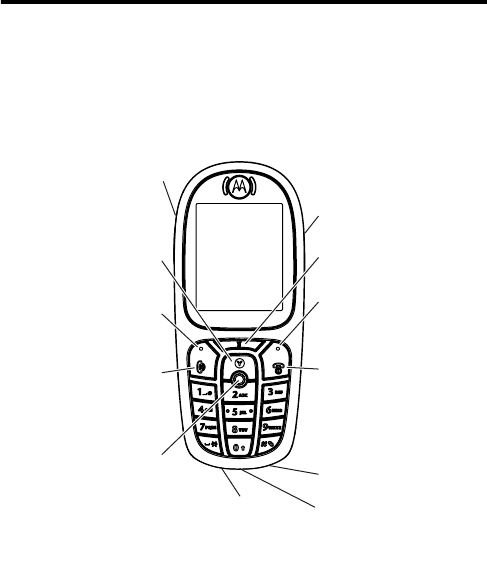
1
Welcome
Welcome to the world of Motorola digital wireless
communications! We are pleased that you have chosen the
Motorola E375 GSM wireless phone.
Note:
Your phone may not appear exactly as shown above.
All key locations, sequences, and functions remain the same
regardless of your phone’s appearance.
Volume Key
Accessory
Connector Port
Insert charger
& phone accessories.
Headset Jack
Camera Key
Activate camera
& take photos.
Menu Key
USB Port
Left Soft Key
Perform function
in lower left display.
Send Key
Make & answer
calls.
Right Soft Key
Perform function
in lower right display.
Power & End Key
Turn phone
on/off, end calls,
exit menu system.
Operator Key
5-Way Navigation
Joystick with
Center Select
Scroll through
menus, press in
to select items.
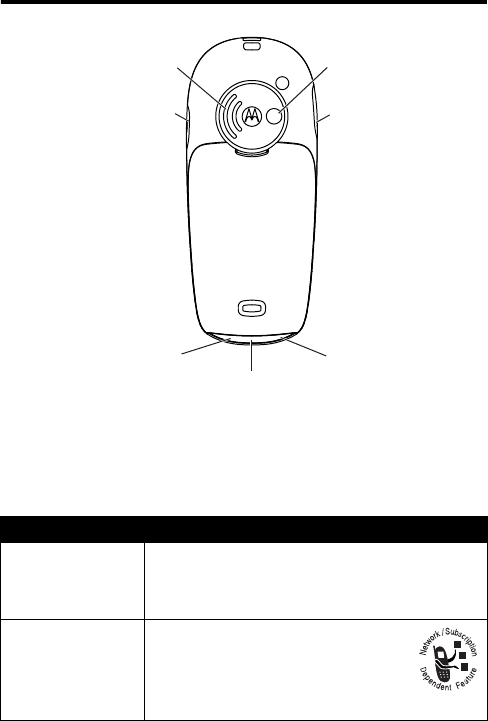
2
Check It Out!
Feature Description
Take Photo
Press the camera key to activate the
camera. Point lens at subject, then press
the camera key to take a photo.
Send Photo
Send a photo to a phone
number or email address:
Press
STORE
(
r
)
>
Send In Message
.
Volume Key
Accessory
Connector Port
Insert charger
& phone accessories.
Headset Jack
Speaker
Camera Key
Activate camera
& take photos.
Camera Lens
USB Port
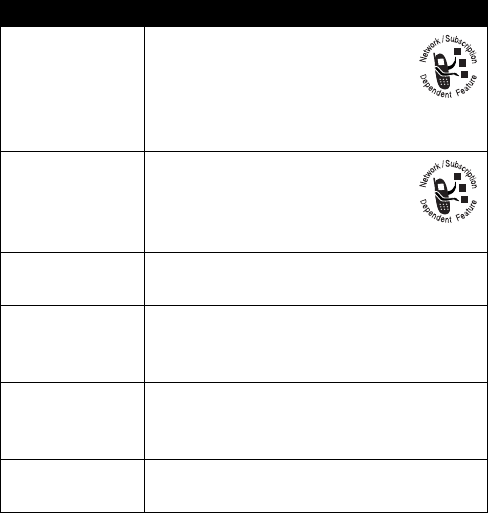
3
Send
Multimedia
Message
Send a multimedia message
with pictures, animations,
sounds, and videos:
m
>
Messages
>
Create Message
>
New Multimedia Msg
Read
Multimedia
Message
Read a new multimedia
message or letter that you have
received:
Press
Read
r
.
Play Video
Clip
Play a video clip:
m
>
Multimedia
>
Videos
> video clip
Phone Skin
Apply a different skin to the phone
display:
m
>
Settings
>
Personalize
>
Skin
> skin
Create Playlist
Create a playlist of songs to play on your
phone:
m
>
Multimedia
>
Sounds
>
[New Playlist]
Play Games
Play a game:
m
>
Games & Apps
> game
Feature Description
4
Motorola, Inc.
Consumer Advocacy Office
1307 East Algonquin Road
Schaumburg, IL 60196
www.motorola.com
1-800-331-6456 (United States)
1-888-390-6456 (TTY/TDD United States for hearing impaired)
1-800-461-4575 (Canada)
MOTOROLA and the Stylized M Logo are registered in the US Patent &
Trademark Office. Java and all other Java-based marks are trademarks
or registered trademarks of Sun Microsystems, Inc. in the U.S. and other
countries. All other product or service names are the property of their
respective owners.
©
Motorola, Inc. 2004.
The information contained in Motorola’s user’s guides is believed to be
correct at the time of printing. Motorola reserves the right to change or
modify any information or specifications without notice. The contents of
Motorola’s user’s guides are provided “as is.” Except as required by
applicable law, no warranties of any kind, either express or implied,
including, but not limited to, the implied warranties of merchantability and
fitness for a particular purpose, are made in relation to the accuracy,
reliability, or contents of this guide.
Caution:
Changes or modifications made in the radio phone, not
expressly approved by Motorola, will void the user’s authority to operate
the equipment.
Manual number: 68XXXXXX32-A

5
Contents
Getting Started
. . . . . . . . . . . . . . . . . . . . . . . . . . . . . . . . . . 8
Installing the SIM Card . . . . . . . . . . . . . . . . . . . . . . . . . . . 9
Battery Tips . . . . . . . . . . . . . . . . . . . . . . . . . . . . . . . . . . . 9
Installing the Battery . . . . . . . . . . . . . . . . . . . . . . . . . . . . 10
Charging the Battery. . . . . . . . . . . . . . . . . . . . . . . . . . . . 11
Turning Your Phone On. . . . . . . . . . . . . . . . . . . . . . . . . . 13
Adjusting Volume . . . . . . . . . . . . . . . . . . . . . . . . . . . . . . 14
Making a Call . . . . . . . . . . . . . . . . . . . . . . . . . . . . . . . . . 14
Answering a Call. . . . . . . . . . . . . . . . . . . . . . . . . . . . . . . 15
Viewing Your Phone Number . . . . . . . . . . . . . . . . . . . . . 15
Locking and Unlocking the Keypad. . . . . . . . . . . . . . . . . 16
Highlight Features
. . . . . . . . . . . . . . . . . . . . . . . . . . . . . . 17
Creating a Music Playlist . . . . . . . . . . . . . . . . . . . . . . . . 17
Taking and Sending a Photo. . . . . . . . . . . . . . . . . . . . . . 18
Changing Phone Skin. . . . . . . . . . . . . . . . . . . . . . . . . . . 20
Sending a Multimedia Message . . . . . . . . . . . . . . . . . . . 21
Playing Video Clips. . . . . . . . . . . . . . . . . . . . . . . . . . . . . 24
Learning to Use Your Phone
. . . . . . . . . . . . . . . . . . . . . . 26
Using the Display . . . . . . . . . . . . . . . . . . . . . . . . . . . . . . 26
Using the 5-Way Navigation Joystick . . . . . . . . . . . . . . . 31
Using Menus. . . . . . . . . . . . . . . . . . . . . . . . . . . . . . . . . . 32
Entering Text. . . . . . . . . . . . . . . . . . . . . . . . . . . . . . . . . . 34
Using the Operator Key . . . . . . . . . . . . . . . . . . . . . . . . . 45
Using the Handsfree Speaker. . . . . . . . . . . . . . . . . . . . . 45
Changing a Code, PIN, or Password . . . . . . . . . . . . . . . 46
Locking and Unlocking Your Phone . . . . . . . . . . . . . . . . 46
If You Forget a Code, PIN, or Password . . . . . . . . . . . . . 48
Using the Phonebook . . . . . . . . . . . . . . . . . . . . . . . . . . . 49
6
Using Voice Record. . . . . . . . . . . . . . . . . . . . . . . . . . . . 51
Setting Up Your Phone
. . . . . . . . . . . . . . . . . . . . . . . . . . 52
Storing Your Name and Phone Number . . . . . . . . . . . . 52
Setting the Time and Date . . . . . . . . . . . . . . . . . . . . . . 52
Setting a Ring Style. . . . . . . . . . . . . . . . . . . . . . . . . . . . 52
Activating Multi-Key Answer . . . . . . . . . . . . . . . . . . . . . 53
Setting a Wallpaper Image . . . . . . . . . . . . . . . . . . . . . . 53
Setting a Screen Saver Image . . . . . . . . . . . . . . . . . . . 54
Adjusting the Backlight . . . . . . . . . . . . . . . . . . . . . . . . . 55
Setting Display Timeout . . . . . . . . . . . . . . . . . . . . . . . . 56
Calling Features
. . . . . . . . . . . . . . . . . . . . . . . . . . . . . . . 57
Changing the Active Line . . . . . . . . . . . . . . . . . . . . . . . 57
Redialing a Number . . . . . . . . . . . . . . . . . . . . . . . . . . . 57
Using Automatic Redial. . . . . . . . . . . . . . . . . . . . . . . . . 58
Using Caller ID . . . . . . . . . . . . . . . . . . . . . . . . . . . . . . . 58
Canceling an Incoming Call . . . . . . . . . . . . . . . . . . . . . 59
Turning Off a Call Alert . . . . . . . . . . . . . . . . . . . . . . . . . 60
Calling an Emergency Number . . . . . . . . . . . . . . . . . . . 60
Dialing International Numbers. . . . . . . . . . . . . . . . . . . . 60
Viewing Recent Calls . . . . . . . . . . . . . . . . . . . . . . . . . . 61
Returning an Unanswered Call . . . . . . . . . . . . . . . . . . . 62
Using the Notepad . . . . . . . . . . . . . . . . . . . . . . . . . . . . 63
Attaching a Number . . . . . . . . . . . . . . . . . . . . . . . . . . . 64
Calling With Speed Dial . . . . . . . . . . . . . . . . . . . . . . . . 64
Calling With 1-Touch Dial . . . . . . . . . . . . . . . . . . . . . . . 64
Using Voicemail. . . . . . . . . . . . . . . . . . . . . . . . . . . . . . . 65
Using Call Waiting. . . . . . . . . . . . . . . . . . . . . . . . . . . . . 66
Putting a Call On Hold. . . . . . . . . . . . . . . . . . . . . . . . . . 67
Transferring a Call. . . . . . . . . . . . . . . . . . . . . . . . . . . . . 67
Phone Features
. . . . . . . . . . . . . . . . . . . . . . . . . . . . . . . . 69
Main Menu . . . . . . . . . . . . . . . . . . . . . . . . . . . . . . . . . . 69
7
Settings Menu. . . . . . . . . . . . . . . . . . . . . . . . . . . . . . . . . 70
Feature Quick Reference . . . . . . . . . . . . . . . . . . . . . . . . 71
Troubleshooting
. . . . . . . . . . . . . . . . . . . . . . . . . . . . . . . . 89
Specific Absorption Rate Data
. . . . . . . . . . . . . . . . . . . . 90
Index
. . . . . . . . . . . . . . . . . . . . . . . . . . . . . . . . . . . . . . . . . 92
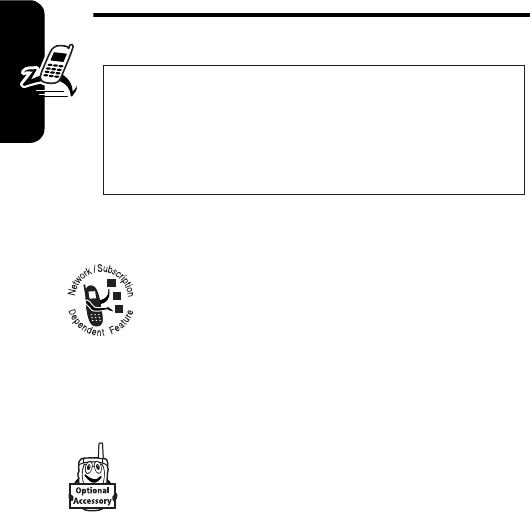
8
Getting Started
Getting Started
Optional Features
This label identifies an optional network, SIM
card, or subscription-dependent feature that
may not be offered by all service providers in all
geographical areas. Contact your service
provider for more information.
Optional Accessories
This label identifies a feature that requires an
optional Motorola Original™ accessory.
CAUTION: Before using the phone for the
first time, read the
Important Safety and
Legal Information
included in the
gray-edged pages at the back of this guide.
032259o
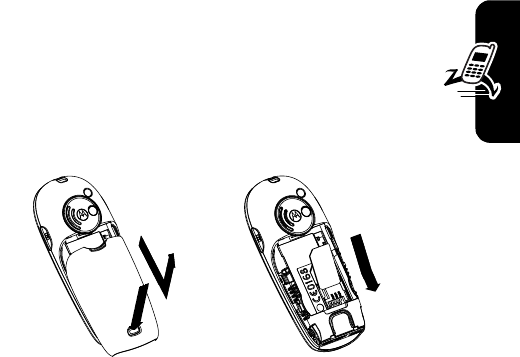
9
Getting Started
Installing the SIM Card
Yo ur Subscriber Identity Module (SIM) card contains
your phone number, service details, and
phonebook/message memory.
Caution:
Do not bend or scratch your SIM card. Avoid
exposing your SIM card to static electricity, water, or dirt.
Battery Tips
Battery life depends on the network, signal strength,
temperature, features, and accessories you use.
•
Always use Motorola Original batteries and chargers.
The warranty does not cover damage caused by
non-Motorola batteries and/or chargers.
•
New batteries or batteries stored for a long time may
take more time to charge.
•
When charging your battery, keep it near room
temperature.
1.
2.

10
Getting Started
•
When storing your battery, keep it uncharged in a
cool, dark, dry place, such as a refrigerator.
•
Never expose batteries to temperatures below
-10°C (14°F) or above 45°C (113°F). Always take
your phone with you when you leave your vehicle.
•
It is normal for batteries to gradually wear down
and require longer charging times. If you notice a
change in your battery life, it is probably time to
purchase a new battery.
Contact your local recycling center for proper
battery disposal.
Warning:
Never dispose of batteries in a fire
because they may explode.
Before using your phone, read the battery safety
information in the “Safety and General Information” section
included in this guide.
Installing the Battery
Your phone is designed to use only
Motorola Original batteries and accessories.
Note:
Your phone is shipped with a protective
clear plastic liner covering the battery door latch. Remove
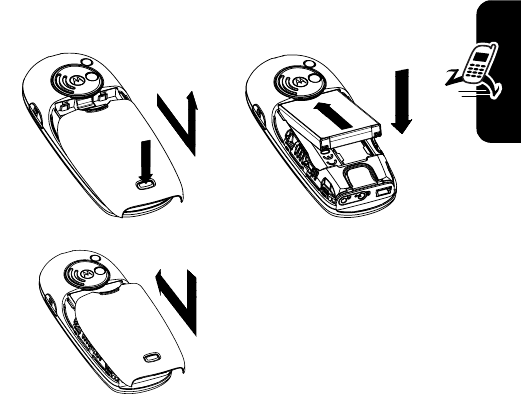
11
Getting Started
the liner to ensure that the battery door attaches and
closes properly.
Charging the Battery
New batteries are shipped partially charged. Before you
can use your phone, you need to install and charge the
battery as indicated by the following instructions. Some
1.
2.
3.
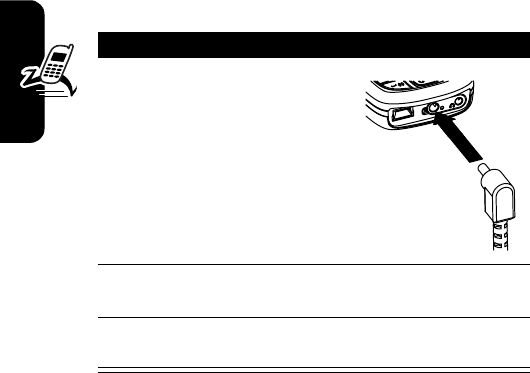
12
Getting Started
batteries perform best after several full charge/discharge
cycles.
Tip:
You can safely leave the travel charger connected to
the phone after charging is complete. This will
not
damage
the battery.
Action
1
Insert the travel charger
plug into your phone.
Note:
It may take up to
10 seconds for your
phone to provide a visible
or audible indication that
the battery is charging.
2
Plug the other end of the travel charger into the
appropriate electrical outlet.
3
When your phone indicates
Charge Complete
,
remove the travel charger.
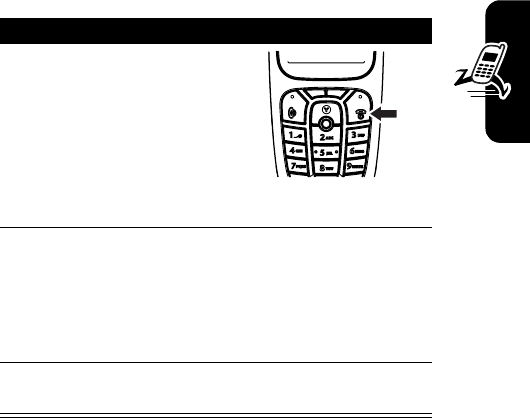
13
Getting Started
Turning Your Phone On
Note:
At startup, you are prompted to personalize your
phone. Select
YES
(
l
) to set personal phone options, or
NO
(
r
) to go to the idle display. For more information
about personalizing your phone, see page 77.
Action
1
Press and hold
e
(power key) for 2
seconds to turn the
phone on.
Note:
It may take up to 4
seconds for the display
to illuminate after you turn the phone on.
2
If necessary, enter your SIM card PIN code and
press
OK
(
r
) to unlock the SIM card.
Caution:
If you enter an incorrect PIN code 3
times in a row, your SIM card is disabled and
your phone displays
SIM Blocked
.
3
If necessary, enter your 4-digit unlock code and
press
OK
(
r
) to unlock the phone.
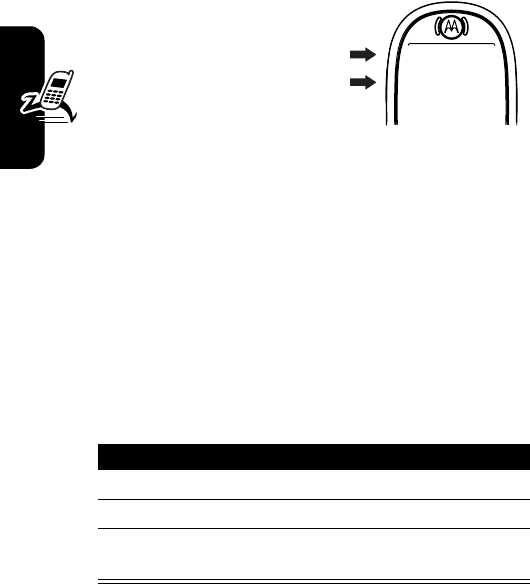
14
Getting Started
Adjusting
Volume
Press the volume key up or
down to:
•
increase or decrease
earpiece volume during a call
•
increase or decrease the ringer volume when the
home screen is visible
Tip:
At the lowest volume setting, press the volume
key down once to switch to vibrate alert. Press it down
again to switch to silent alert. Press the volume key up
to switch back to vibrate alert, then ring alert.
•
turn off an incoming call alert
Making a Call
Note:
You must dial the phone number from the home
screen (see page 26).
Press To
1
keypad keys dial the phone number
2
s
make the call
3
e
end the call and “hang up” the
phone when you are finished

15
Getting Started
Answering a Call
When you receive a call, your phone rings and/or
vibrates and displays an incoming call message.
Viewing Your Phone Number
To view your phone number from the home screen, press
mh
.
While you are on a call, press
m
>
My Tel. Numbers
.
Note:
Your phone number must be stored on your SIM
card to use this feature. To store your phone number on
the SIM card, see page 52. If you do not know your phone
number, contact your service provider.
Press To
1
s
or
ANSWER
(
r
)answer the call
2
e
end the call and “hang up” the
phone when you are finished

16
Getting Started
Locking and Unlocking the
Keypad
You can lock your phone keypad to prevent accidental
keypresses (for example, when carrying your phone in
a purse or pocket).
Select
m
>
Settings
>
Security
>
Lock Keypad
to view
instructions on how to lock/unlock the keypad.
Note:
Incoming calls and messages unlock the keypad.
Press To
mt
lock or unlock your keypad

17
Highlight Features
Highlight Features
You can do much more with your phone than make and
receive calls!
Creating a Music Playlist
Note:
Normal airtime and/or carrier usage charges apply.
You can download and play a variety of different types of
ring tones and music on your phone. You can store these
sound files in phone memory.
Tip:
To see the sound files stored on your phone, go to the
Sounds
menu.
You can create a playlist of selected songs that play in the
order you specify. Playlists you create are stored in the
Sounds
menu.
To create a playlist:
Find the Feature
m
>
Multimedia
>
Sounds
>
[New Playlist]
Press To
1
CHANGE
(
r
)select
Name
2
keypad keys enter a name for the playlist
3
OK
(
r
) store the name
4
CHANGE
(
r
)select
Audio Files
5
n
scroll to a song

18
Highlight Features
To listen to a playlist:
Taking and Sending a Photo
Shortcut:
Press the camera key to activate the camera.
Press the camera key again to take a photo.
To use your phone’s camera using the menu system:
6
CHECK
(
r
) add the song to the playlist
Repeat steps 5 and 6 to add
more songs to the playlist.
7
DONE
(
l
) store the selected songs
8
DONE
(
l
) store the playlist
Find the Feature
m
>
Multimedia
>
Sounds
>playlist name
Find the Feature
m
>
Multimedia
>
Camera
Press To
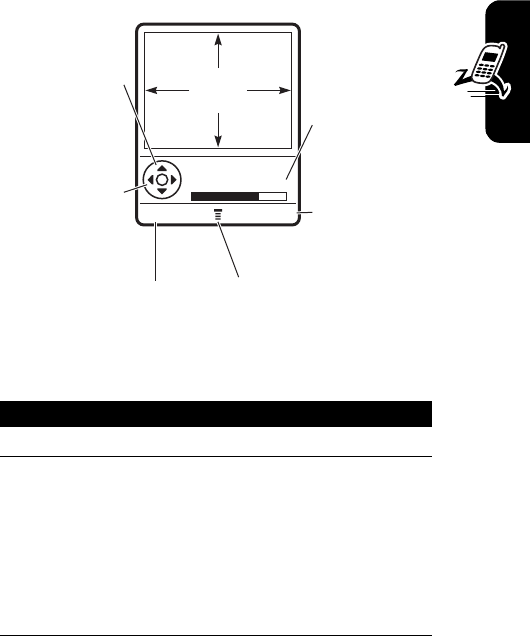
19
Highlight Features
The active viewfinder image appears on your display.
Point the camera lens at the photo subject, then:
Press To
1
CAPTURE
(
r
) take a photo
2
STORE
(
r
)
or
DISCARD
(
l
)
view storage options
delete the photo and return to
active viewfinder
If you choose to store the
photo, continue to step 4.
IMAGE
AREA
BACK CAPTURE
Press
BACK
(l) to return
to previous screen.
Press n up or
down to zoom
in or out.
Press n left or
right to
decrease or
increase image
brightness.
Press m to open
Pictures Menu
.
Photo Storage
Space Used
Press
CAPTURE
(r) to
take a photo.
Photo Viewfinder
Memory Used:72%
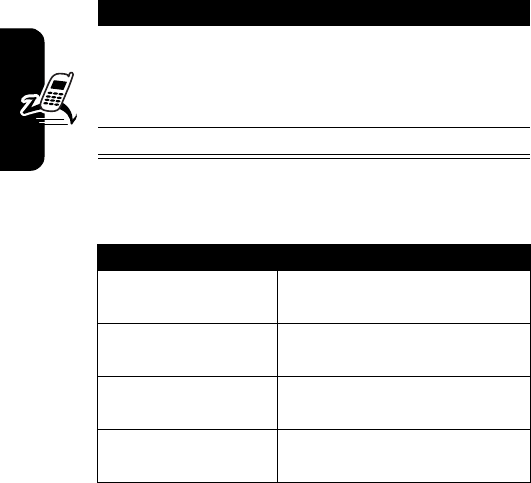
20
Highlight Features
Press
m
to open the
Pictures Menu
when the camera is
active. The
Pictures Menu
can include the following options:
Changing Phone Skin
Change the look and feel of your phone’s display by
selecting a different skin setting.
Your phone displays the new skin. Press
BACK
(
l
) to
return to the previous skin.
3
n
scroll to
Send in Message
,
Store Only
,
Apply as Wallpaper
,
Apply as Screen Saver
, or
Apply as Phonebook Entry
4
SELECT
(
r
) perform the storage option
Option Description
Go To Pictures
View pictures and photos
stored on your phone.
Auto-Timed Capture
Set a timer for the camera to
take a photo.
Pictures Setup
Open the setup menu to
adjust picture settings.
View Free Space
See how much memory
remains for storing pictures.
Find the Feature
m
>
Settings
>
Personalize
>
Skin
>skin
Press To
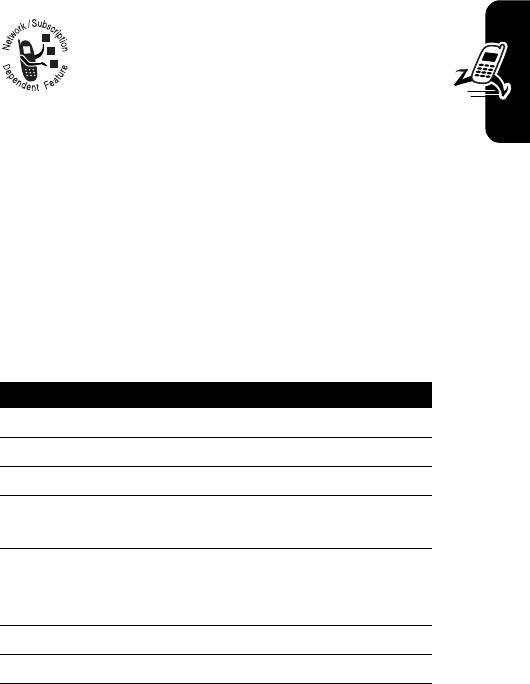
21
Highlight Features
Sending a Multimedia Message
A Multimedia Messaging Service (MMS)
multimedia message contains one or more
slides with text and embedded media
objects (including photos, pictures,
animations, sounds, voice records, and/or video clips).
You can send the multimedia message to other wireless
phone users, and to email addresses.
Note:
Recording of phone calls is subject to varying State
and Federal laws regarding privacy and recording of
phone conversations. Always obey the laws and
regulations on the use of this feature.
Find the Feature
m
>
Messages
>
Create Message
>
New Multimedia Msg
Press To
1
keypad keys enter slide text
2
m
open the
MMS Menu
3
n
scroll to
Insert
4
SELECT
(
r
) display a list of items you can
insert
5
n
scroll to
Picture
,
Voice Record
,
Sound
,
Video
,
New Page
,
Quick Note
,
or
Contact Info
6
SELECT
(
r
) select the file type
7
n
highlight the file you want

22
Highlight Features
8
SELECT
(
r
) insert the file
To add another slide to the
message, continue to step 9.
To send the message, go to
step 14.
9
m
open the
MMS Menu
to insert a
new slide
10
n
scroll to
Insert
11
SELECT
(
r
) display a list of items you can
insert
12
n
scroll to
New Page
13
SELECT
(
r
) insert a new slide after the
current slide
Repeat steps 1 to 8 to enter
contents for the new slide.
14
OK
(
r
) store the message
15
n
scroll to a
Send To
option:
Highlight
[One Time Entry]
to
enter one or more phone
numbers and/or email
addresses.
Highlight
[New Phonebook Entry]
to enter a number/address
and add it to the phonebook.
Or highlight an existing
phonebook entry.
Press To
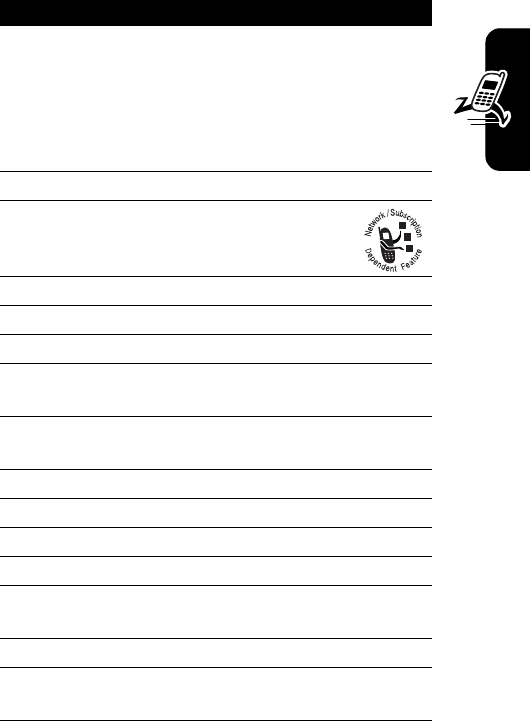
23
Highlight Features
16
SELECT
(
r
)
or
ADD
(
r
)
select
[One Time Entry]
or
[New Phonebook Entry]
add a phonebook entry to the
list of recipients
17
DONE
(
l
) store the numbers/addresses
18
n
scroll to
Subject
19
CHANGE
(
l
)select
Subject
20
keypad keys enter the subject
21
OK
(
r
) store the subject
22
CHANGE
(
l
)select
Attachments
to attach a
file to the message
23
n
scroll to
Picture
,
Voice Record
,
Sound
, or
Video
24
SELECT
(
r
) select the file type
25
n
highlight the file you want
26
SELECT
(
r
) attach the file
27
BACK
(
l
) return to the message editor
28
n
scroll to
Receipt
to request a
receipt, if desired
29
CHANGE
(
l
)select
Receipt
30
ADD
(
r
) or
REMOVE
(
r
)activate/deactivate the
delivery report
Press To

24
Highlight Features
Playing Video Clips
Note:
Normal airtime and/or carrier usage charges apply.
You can download and play video clips on your phone.
You can store these video clips in phone memory.
To play a video clip:
31
DONE
(
l
) return to the message editor
32
SEND
(
r
)
or
m
send the message
view message details, save
the message in the drafts
folder, or cancel the message
Find the Feature
m
>
Multimedia
>
Videos
>video clip
Press To
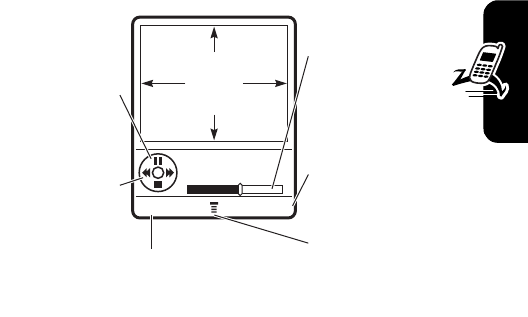
25
Highlight Features
The video clip displays in the video clip playback screen:
VIDEO
CLIP
AREA
BACK DETAILS
Press n up or
down to pause
or play video
clip.
Press n left or
right to skip to
previous or
next video clip.
Press
BACK
(l) to
return to previous
screen.
Press
m
to
open
Videos
Menu
.
Timer indicates
% played.
Press
DETAILS
(l) to
view video clip
information.
Video Clip Name
Playing
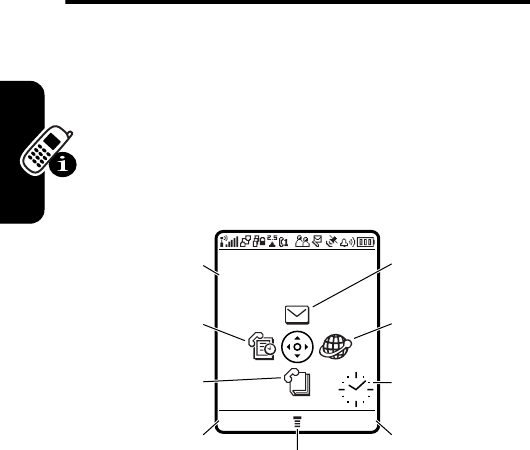
26
Learning to Use Your Phone
Learning to Use Your
Phone
See page 1 for a basic phone diagram.
Using the Display
The home screen is displayed when you are
not
on a
call or using the menu. You must be in the home
screen to dial a phone number.
Press the 5-way navigation joystick (
n
) up, down, left, or
right to select a menu feature icon. If you select a menu
icon by mistake, press
e
to return to the home screen.
The
e
(menu) indicator shows that you can press the
menu key (
m
) to enter the main menu.
Menu Indicator
ServiceProvider
10/15/04
STYLES SOUND
Left Soft Key
Label
Right Soft Key
Label
Date
RecentCalls
Messages
Clock
Browser
Phonebook

27
Learning to Use Your Phone
Labels at the bottom corners of the display show the
current soft key functions. Press the left soft key (
l
) or
right soft key (
r
) to perform the indicated function.
Notes:
•
Your home screen may appear different from the
screen shown. For example, your service provider
may hide the menu feature icons to allow a better view
of the wallpaper image. You can still select the
menu icons when they are hidden from view. To
show or hide menu icons, see page 78.
•
Your phone can display an analog or digital clock
in the home screen (see page 78).
•
Your phone’s display normally is visible only when the
display backlight is on, or when the display is viewed
in direct sunlight. To extend battery life, the backlight
turns off automatically when no activity is detected for
a specified time. The backlight turns back on when
you press any key. To set the time that the backlight
stays on, see page 55.
•
To extend battery life, you can set the display to turn
off after a specified inactivity. The display turns back
on when you press any key. To set the time that the
display stays on, see page 56.
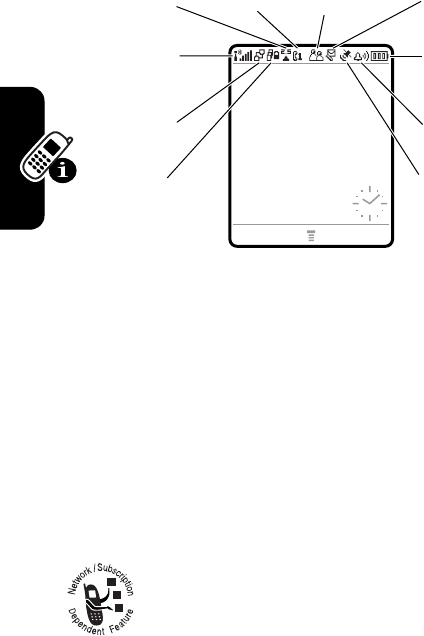
28
Learning to Use Your Phone
The following status indicators can display:
1. Data Transmission Indicator
Shows connection and
data transmission status. Indicators can include:
2. GPRS Indicator
Shows that your phone is
using a high-speed General Packet Radio
4
= secure packet
data transfer
7
= unsecure packet
data transfer
3
= secure
application
connection
6
= unsecure
application
connection
2
= secure Circuit
Switch Data
(CSD) call
5
= unsecure CSD
call
ServiceProvider
10/15/04
STYLES SOUND
3.
Signal
Strength
8.
Battery
Level
2.
GPRS
9.
Ring Style
1.
Data
Transmission
10.
Location
6.
Messaging
Presence
7.
Message
4.
Roam
5.
Active
Line
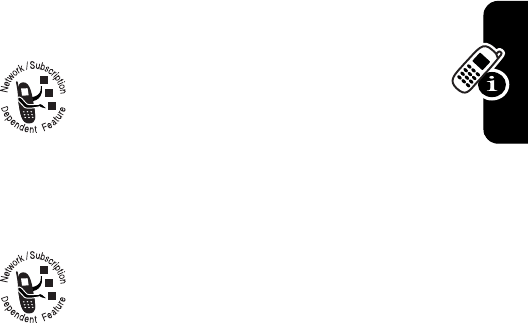
29
Learning to Use Your Phone
Service (GPRS) network connection. GPRS allows faster
data transfer speeds. Other indicators can include:
3. Signal Strength Indicator
Vertical bars show the
strength of the network connection. You cannot make or
receive calls when the
!
(no signal) indicator or
)
(no
transmit) indicator is displayed.
4. Roam Indicator
Shows when your
phone is seeking or using another network
outside your home network. Indicators can
include:
5. Active Line Indicator
Shows
@
or
B
to
indicate the currently active phone line. Other
indicators can include:
*
= GPRS PDP
context active
,
= GPRS packet
data available
8
=2.5G home
9
=2.5G roam
:
=2G home
;
= 2G roam
A
= line 1 active,
call forward on
C
= line 2 active, call
forward on
E
= alarm activated
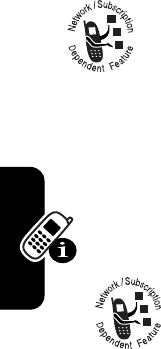
30
Learning to Use Your Phone
6. Messaging Presence Indicator
Shows
when instant messaging is active. Indicators can
include:
When a Java™ application is active, a
`
(Java midlet)
indicator can display in this location.
7. Message Indicator
Displays when you
receive a new message. Indicators can
include:
When you enter a message, a number in this location
shows the number of characters left on the current page
(text message), or the message size in bytes/kilobytes
(multimedia message or letter).
8. Battery Level Indicator
Vertical bars show the battery
charge level. Recharge the battery when
Low Battery
displays and the battery alert sounds.
P
=IM active
I
= available for IM
_
=busy
Q
= invisible to IM
J
= available for
phone calls
X
= offline
r
=text message
t
=voicemail
message
s
= voicemail and
text message
b
= answering
machine
d
= IM message
a
= active chat
session
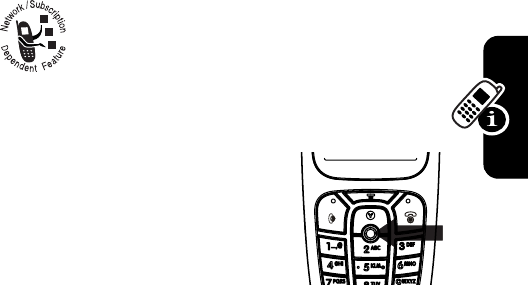
31
Learning to Use Your Phone
9. Ring Style Indicator
Shows the ring style setting.
10. Location Indicator
Your phone may be
able to send location information to the network
during an emergency call. Indicators show when
your phone is sending location information:
Using the 5-Way
Navigation
Joystick
Press the 5-way navigation
joystick (
n
) up, down, left, or right
to scroll through the menu system, highlight menu items,
change feature settings, and play games. Press the 5-way
navigation joystick (
n
) in to select a highlighted menu
item.
y
= loud ring
z
= soft ring
|
=vibrate
}
= vibrate and ring
{
= silent
Ö
= location on
Ñ
= location off
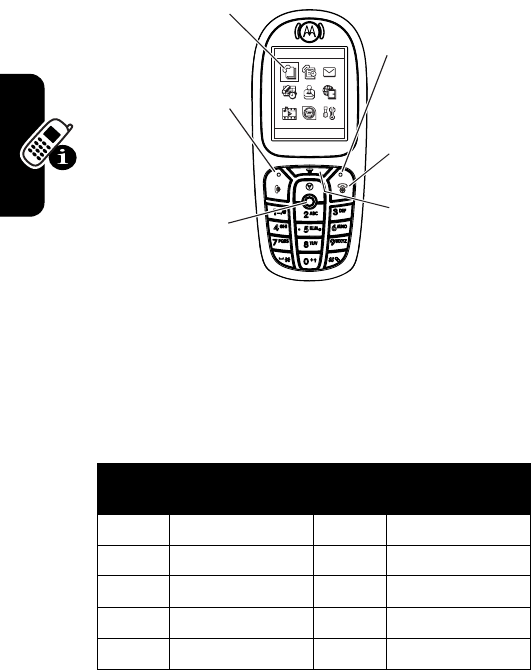
32
Learning to Use Your Phone
Using Menus
From the home screen, press
m
to enter the main
menu.
Press
n
to scroll to and highlight a menu feature icon in
the main menu. The following icons represent features that
may display in the main menu, depending on your service
provider and service subscription options.
Menu
Icon Feature Menu
Icon Feature
n
Phonebook
s
Recent Calls
e
Messages
É
Office Tools
Q
Games & Apps
á
Web Access
h
Multimedia
ã
IM
w
Settings
K
Chat
Menu Key
Enter menu
system, or open a
sub-menu.
Right Soft Key
Perform right
function.
5-Way Navigation
Joystick With
Center Select
Scroll up, down,
left, or right. Press
in to select menu
item.
Left Soft Key
Perform left
function.
Highlighted
Menu Feature
Icon
End Key
Exit menu without
making changes.
Phonebook
EXIT SELECT
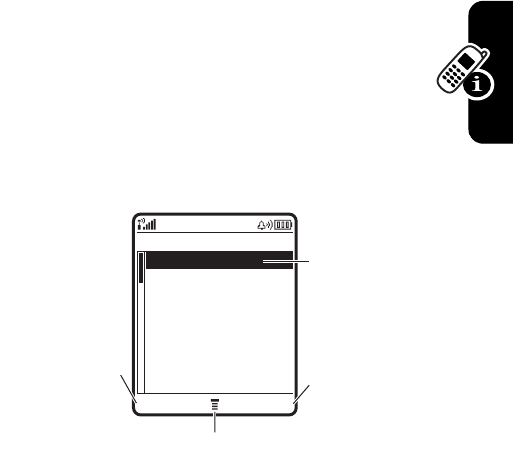
33
Learning to Use Your Phone
Selecting a Menu Feature
This guide shows you how to select a menu feature,
starting from the home screen.
This example shows that from the home screen, you must
press
m
, scroll to and select
s
Recent Calls
from the
main menu, then scroll to and select
Dialed Calls
. Press
n
to scroll. Press
n
in to select the highlighted item.
Press the left/right soft keys to select the functions
listed in the bottom left and right corners of the display.
Selecting a Feature Option
Some features require you to select an option from a list:
•
Press
n
to scroll up or down to highlight the option
you want.
Find the Feature
m
>
Recent Calls
>
Dialed Calls
Dialed Calls
BACK VIEW
Press
m
to open sub-menu.
Press
VIEW
(r) to
view details of
highlighted
option.
Press
BACK
(l) to go
back to
previous
screen.
Highlighted
Option
10) John Smith
9)
Lisa Owens
8)
Adda Thomas
7)
Jack Bradshaw
6)
Dave Thompson
5)
John Smith
4)
John Smith
3)
John Smith
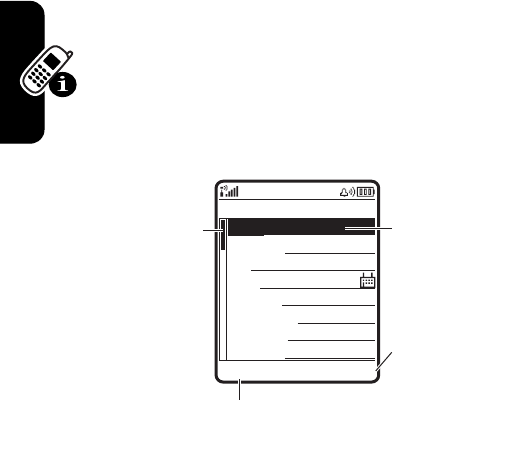
34
Learning to Use Your Phone
•
In a numbered list, press a number key to highlight the
option.
•
In an alphabetized list, press a key repeatedly to cycle
through the letters on the key and highlight the closest
matching list option.
•
When an option has a list of possible values, press
n
left or right to scroll through and select a value.
•
When an option has a list of possible numeric
values, press a number key to set the value.
Entering Text
Some features require you to enter information.
Entry Details
CANCEL CHANGE
Press
CANCEL
(l) to exit without
making changes.
DONE
(l) displays
when you enter or edit information.
Press
CHANGE
(r) to
enter or edit
information.
Press n to
scroll down to
other options.
Highlighted
Option
Name: John Smith
Category: General
No.: 212-555-1212
Type: Work
Store To: Phone
Voice Name:
Speed No.: 2 #(P)
Ringer ID: Continental
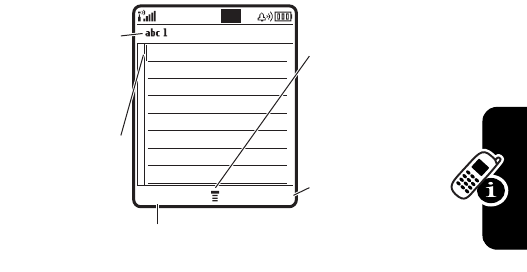
35
Learning to Use Your Phone
The message center lets you compose and send text
messages.
Choosing a Text Entry Mode
Multiple text entry modes make it easy for you to enter
names, numbers, and messages. The mode you select
remains active until you select another mode.
Press
h
in any text entry screen to select one of the
following entry modes:
Primary
The primary text entry mode (see
Setting Up a Text Entry Mode to
set).
Numeric
Enter numbers only (see page 42).
Symbol
Enter symbols only (see page 43).
Secondary
The secondary text entry mode (see
Setting Up a Text Entry Mode to
set).
450
Msg
CANCEL INSERT
Press
CANCEL
(l) to exit without
making changes.
Press
INSERT
(r) to insert a
quick note,
picture, or
sound.
For indicator
descriptions,
see following
section.
Flashing cursor
indicates
insertion point.
Press
m
to
open sub-
menu.

36
Learning to Use Your Phone
Alternatively, you can select a text entry mode in any text
entry screen by pressing
m
>
Entry Mode
.
Setting Up a Text Entry Mode
Press
m
>
Entry Setup
from any text entry screen.
Select
Primary Setup
or
Secondary Setup
, and choose:
Using Capitalization
Press
0
in any text entry screen to change text case. The
following indicators show capitalization status:
Text Entry Mode Indicators
When you select the
Primary
or
Secondary
text entry mode,
indicators at the top of the display identify the text entry
setting:
iTAP
Use iTAP
®
mode to let the phone
predict each word as you press keys
(see page 40).
Tap
Enter letters and numbers by pressing
a key one or more times.
Tap Extended
Enter letters, numbers, and symbols
by pressing a key one or more times.
None
Hide the
Secondary
setting (only
available for
Secondary Setup
).
U
= no capital letters
V
= capitalize next
letter only
T
= all capital letters
Primary
Secondary
g
m
Tap, no capital letters

37
Learning to Use Your Phone
The following indicators identify
Numeric
or
Symbol
entry
mode:
Using Tap Mode
This is the standard mode for entering text on your phone.
Tap
mode cycles through the letters and number of the key
you press.
Tap Extended
mode also cycles through additional
symbols as shown in the “Character Chart” on page 39.
h
q
Tap, capitalize next letter
only
f
l
Tap, all capital letters
j
p
iTAP, no capital letters
k
n
iTAP, capitalize next
letter only
i
o
iTAP, all capital letters
W
= numeric mode
[
= symbol mode
Press To
1
a keypad key
one or more
times
select a letter, number, or
symbol
2
keypad keys enter remaining characters
Tip:
Press
n
right to accept a
word completion, or
t
to
insert a space.
3
OK
(
r
) store the text
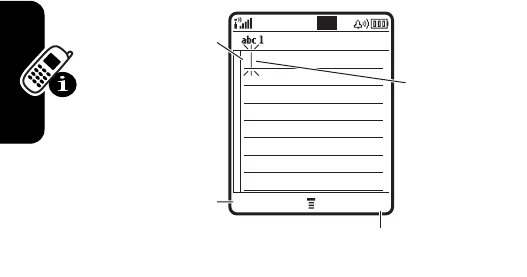
38
Learning to Use Your Phone
In a text entry screen, you can press
h
to switch entry
modes. An indicator shows which mode is active (see
page 36). If
Tap
or
Tap Extended
is not available as the
Primary
or
Secondary
entry mode, see page 36.
When you enter text with
Tap
or
Tap Extended
mode, the soft
key functions change.
449
Msg
DELETE OK
Press
DELETE
(l) to
delete
character to left
of insertion
point. Press
OK
(r) to accept
and store text.
Character
displays at
insertion point.
After
2 seconds,
character is
accepted and
cursor moves
to next
position.
T
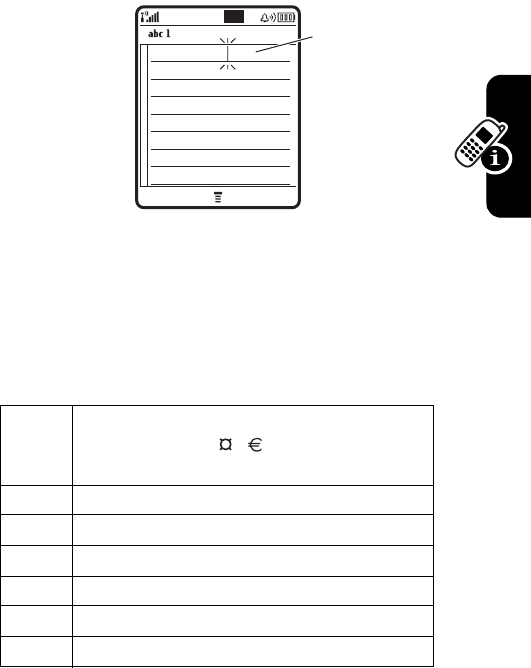
39
Learning to Use Your Phone
When you enter 3 or more characters in a row, your phone
may guess the rest of the word. For example, if you enter
prog
you might see:
If you want a different word (such as
progress
), continue
pressing keypad keys to enter the remaining characters.
Character Chart
Use this chart as a guide for entering characters with
Tap Extended
mode.
1
. 1 ? ! , @ _ & ~ : ; " - ( ) '
¿ ¡ % £ $ ¥ + x * / \ [ ]
= > < # §
2
a b c 2 ä å á à â ã
α
β
ç
3
d e f 3
δ
ë é è ê
φ
4
g h i 4 ï í î
γ
5
j k l 5
λ
6
m n o 6 ñ ö ø ó ò ô õ
ω
7
p q r s 7
π
ß
σ
432
Msg
DELETE OK
Press
m
right to accept
program
, or
press t to
reject it and
enter a space
after
prog
.
This is a prog ram
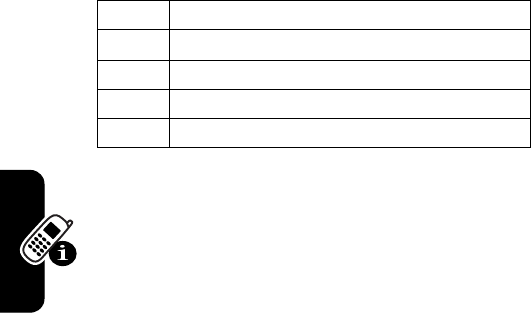
40
Learning to Use Your Phone
Note:
This chart may not reflect the exact character set
available on your phone. In an email or Web address
editor,
1
first shows common characters for that
editor.
Tap Mode Text Entry Rules
•
Press a keypad key repeatedly to cycle through its
characters.
•
Press
n
left or right to move the flashing cursor to the
left or right in a text message.
•
The first character of every sentence is capitalized. If
necessary, press
n
down to change the character to
lowercase before the cursor moves to the next
position.
•
If you enter or edit information and do not want to
save the changes, press
e
to exit without saving.
Using iTAP Mode
iTAP software provides a predictive text entry mode that
lets you enter a word using one keypress per letter. This
can be faster than
Tap
mode, because your phone
combines the keypresses into common words.
8
t u v 8
θ
ü ú ù û
9
w x y z 9
ξ ψ
0
change text case, for capital letters
t
enter a space (hold to enter a return)
h
change text entry mode (hold for default)
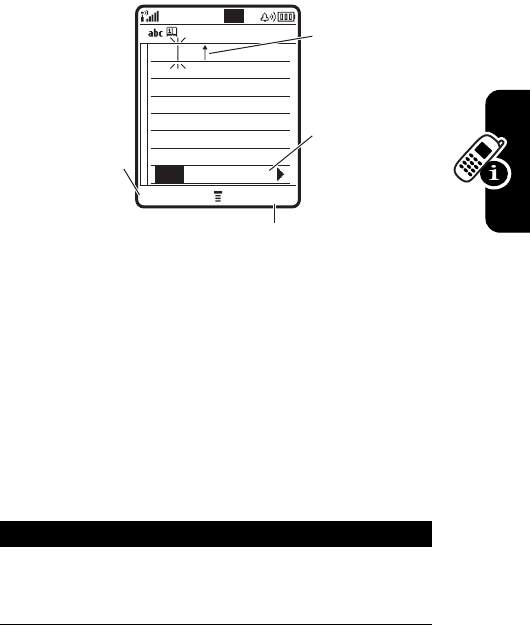
41
Learning to Use Your Phone
For example, if you press
7
7
6
4
, letter
combinations that match your keypresses display:
If you want a different word (such as
Progress
), continue
pressing keypad keys to enter the remaining characters.
Entering Words
In a text entry screen, you can press
h
to switch entry
modes. An indicator tells you which mode is active (see
page 36). If
iTAP
mode is not available as the
Primary
or
Secondary
entry mode, see page 36.
Press To
1
keypad keys
(one press per
letter)
show possible letter
combinations at the bottom of
the display
442
Msg
DELETE SELECT
Press
SELECT
(r) to select
highlighted combination.
Press n up to
accept
Program
.
Press
DELETE
(l) to
delete last
letter.
Press n right to
highlight
another
combination.
Press t to
enter
Prog
and
a space.
Prog ram
Prog Proh Spoi Proi

42
Learning to Use Your Phone
If you enter a word your phone does not recognize, the
phone stores it to use as one of your word options. When
you fill memory space for unrecognized words, your phone
deletes the oldest words to add new words.
Using Numeric Mode
In a text entry screen, press
h
to switch entry modes until
the
W
(numeric) indicator displays.
Press keypad keys to enter the numbers you want. When
you finish entering numbers, press
h
to switch to another
entry mode.
2
n
left or right highlight the combination you
want
3
SELECT
(
r
)
or
t
select the highlighted
combination
You can press keypad keys
to add more letters to the end
of the combination.
enter the highlighted
combination when it spells a
word
A space is automatically
inserted after the word.
Press To
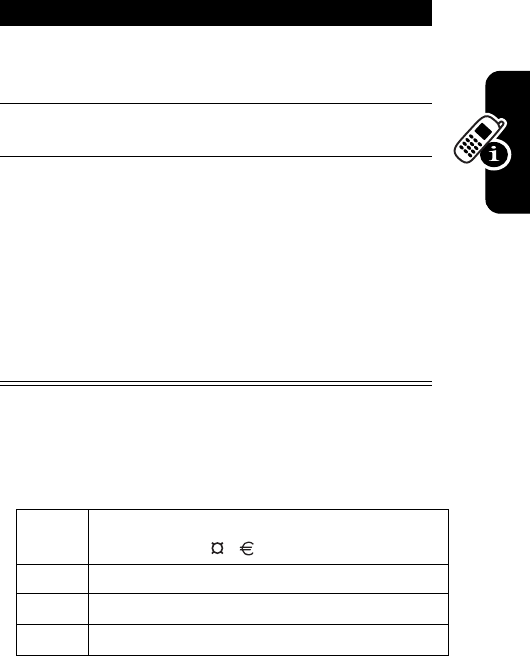
43
Learning to Use Your Phone
Using Symbol Mode
In a text entry screen, press
h
to switch entry modes until
the
[
(symbol) indicator displays.
Symbol Chart
Use this chart as a guide for entering characters with
symbol mode.
Press To
1
keypad keys
(one press per
symbol)
show possible symbol
combinations at the bottom of
the display
2
n
left or right highlight the combination you
want
3
SELECT
(
r
)
or
t
select the highlighted
combination
You can press keypad keys
to add more symbols to the
end of the combination.
enter the highlighted
combination
1
. ? ! , @ _ & ~ : ; " - ( ) ' ¿
¡ % £ $ ¥
2
@ _ \
3
/ : ;
4
" & '
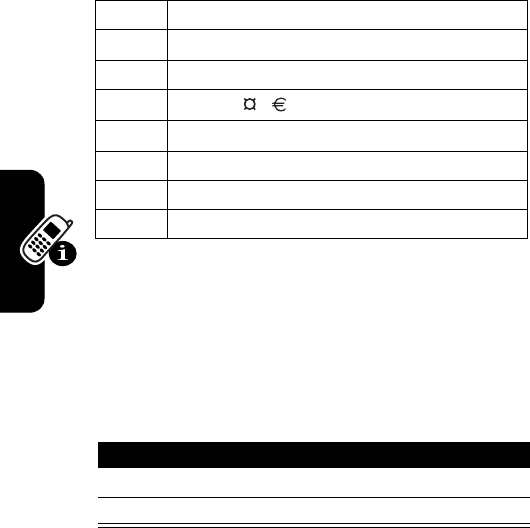
44
Learning to Use Your Phone
Note:
This chart may not reflect the exact character set
available on your phone. In an email or Web address
editor,
1
first shows common characters for that editor.
Deleting Letters and Words
Place the cursor to the right of the text you want to delete,
and then:
5
( ) [ ] { }
6
¿ ¡ ~
7
< > =
8
$ £ ¥
9
# % *
0
+ - x * / = > < # §
t
enter a space (hold to enter a return)
h
change text entry mode (hold for default)
Action
Press
DELETE
(
l
) to delete one letter at a time.
Hold
DELETE
(
l
) to delete the entire message.
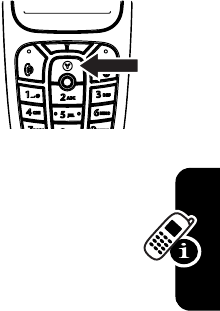
45
Learning to Use Your Phone
Using the Operator
Key
The operator key gives you direct
access to the operator services.
With the home screen displayed,
press the operator key to access your service provider.
The features available may vary depending on your
service provider.
Note:
Operator key can be activated only when in
home screen.
Using the Handsfree Speaker
Note:
The use of wireless devices and their accessories
may be prohibited or restricted in certain areas. Always
obey the laws and regulations on the use of these
products.
When you activate your phone’s integrated handsfree
speaker, you can talk to the other party without holding the
phone to your ear.
Press
SPEAKER
(
r
) to turn the handsfree speaker on or off
during a call.
When you turn the handsfree speaker on, your phone
displays
Speaker On
in the home screen. The handsfree
speaker remains on until you press
SPEAKER
(
r
) again or
turn the phone off.

46
Learning to Use Your Phone
Note:
The handsfree speaker is disabled when you
connect your phone to a handsfree car kit or headset
accessory.
Changing a Code, PIN, or
Password
Your phone’s 4-digit unlock code is originally set to 1234,
and the 6-digit security code is originally set to 000000.
Your service provider may reset these codes before
you receive your phone.
If your service provider has
not
reset these codes, we
recommend that you change them to prevent others from
accessing your personal information. The unlock code
must contain 4 digits, and the security code must contain 6
digits.
You can also reset your SIM card PIN code, PIN2 code,
and/or call barring password if necessary.
To change a code or password:
Locking and Unlocking Your
Phone
You can lock your phone manually or set the phone to lock
automatically whenever you turn it off.
Find the Feature
m
>
Settings
>
Security
>
New Passwords

47
Learning to Use Your Phone
To use a locked phone, you must enter the unlock code. A
locked phone still rings or vibrates for incoming calls or
messages,
but you must unlock it to answer
.
You can make emergency calls on your phone even when
it is locked (see page 60).
Locking Your Phone Manually
Unlocking Your Phone
Tip:
Your phone’s unlock code is originally set to 1234.
Your service provider may reset the unlock code to the last
4 digits of your phone number.
At the
Enter Unlock Code
prompt:
Find the Feature
m
>
Settings
>
Security
>
Phone Lock
>
Lock Now
Press To
1
keypad keys enter your unlock code
2
OK
(
r
) lock the phone
Press To
1
keypad keys enter your unlock code
2
OK
(
r
) unlock your phone

48
Learning to Use Your Phone
Setting Your Phone to Lock Automatically
You can set your phone to lock whenever you turn it off:
If You Forget a Code, PIN, or
Password
Note:
Your phone’s 4-digit unlock code is originally set to
1234, and the 6-digit security code is originally set to
000000. Your service provider may reset the unlock code
to the last 4 digits of your phone number before you
receive your phone.
If you forget your unlock code, try entering 1234 or the last
4 digits of your phone number. If that does not work, at the
Enter Unlock Code
prompt:
Find the Feature
m
>
Settings
>
Security
>
Phone Lock
>
Automatic Lock
>
On
Press To
1
keypad keys enter your unlock code
2
OK
(
r
) activate automatic lock
Press To
1
m
display the unlock code
bypass screen
2
keypad keys enter your security code
3
OK
(
r
) submit your security code

49
Learning to Use Your Phone
If you forget your security code, SIM card PIN code, PIN2
code, or call barring password, contact your service
provider.
Using the Phonebook
This section describes basic phonebook operations. For
more information about using the phonebook, see
page 75.
Storing a Phone Number
Enter a phone number in the home screen, then press
STORE
(
r
) to create a phonebook entry with that number.
Fill in the other fields to complete the entry.
Select
MORE
to store another number (for example, a work
number) for the same
Name
.
Recording a Voice Name
When creating a phonebook entry, scroll to
Voice Name
and
press
RECORD
(
r
) to begin. When prompted, press
RECORD
(
r
) and say the entry’s name (within 2 seconds).
When prompted, press
RECORD
(
r
) and repeat the name.
Press
DONE
(
l
) to store the voice name.
Note:
This option is not available for entries stored on the
SIM card.
Dialing a Number
Press
m
>
Phonebook
, highlight the phonebook entry,
press
s
to call.

50
Learning to Use Your Phone
Voice Dialing a Number
To set the Voice Dial Key, see page 75.
From the home screen, press
V.DIAL
(
r
), then say the
entry’s name (within 2 seconds) to call.
Note:
This option is not available for entries stored on the
SIM card.
Sorting Phonebook Entries
Press
m
>
Phonebook
, press
m
>
Setup
>
Sort by
,
then select whether you want to sort the phonebook list
by
Name
,
Speed No.
,
Voice Name
, or
Email
.
When sorting by name, you can view
All
numbers or just
the
Primary
number for each name. To set the primary
number for a name, see page 77.
Setting a Picture ID for a Phonebook Entry
Press
m
>
Phonebook
> entry, press
m
>
Edit
>
Picture
>picture name.
Also see pages 2 and 18.
Note:
The
Picture
option is not available for entries stored
on the SIM card.
Setting Picture ID View
Press
m
>
Phonebook
, press
m
>
Setup
>
View by
>
Picture
.
Note:
The
Picture
option is not available for entries stored
on the SIM card.
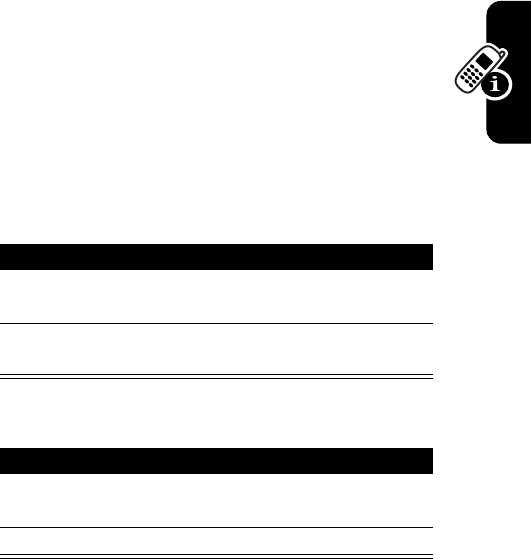
51
Learning to Use Your Phone
Viewing Entries By Category
Press
m
>
Phonebook
, press
m
>
Categories
, then
select whether you want to view
All
entries, entries in a
predefined category (
Business
,
Personal
,
General
,
VIPs
), or
entries in a category you created.
To set the category for a phonebook entry, see page 76.
Using Voice Record
You can record a voice memo using the camera key.
Note:
Recording of phone calls is subject to varying
State and Federal laws regarding privacy and recording of
phone conversations. Always obey the laws and
regulations on the use of this feature.
Record a voice memo:
Listen a voice memo:
Action
1
Press and hold the camera key to start recording
and speak to the phone.
2
Release the camera key to stop the recording. A
label indicating time and date is displayed.
Action
1
Press
m
>
Office Tools
>
Voice Records
>Voice
Memo.
2
Listen the recorded voice memo.

52
Setting Up Your Phone
Setting Up Your
Phone
Storing Your Name and Phone
Number
To store or edit your name and phone number
information on your SIM card:
Shortcut:
Press
mh
from the home screen to
edit your name and phone number.
If you do not know your phone number, contact your
service provider.
Setting the Time and Date
You must set the time and date to use the datebook.
Setting a Ring Style
Your phone rings or vibrates to notify you of an incoming
call or other event. This ring or vibration is called an alert.
Find the Feature
m
>
Settings
>
Phone Status
>
My Tel. Numbers
Find the Feature
m
>
Settings
>
Initial Setup
>
Time and Date

53
Setting Up Your Phone
You can select one of 5 different ring styles. The ring style
indicator in the display shows the current ring style (see
page 31).
To set a ring style:
Each ring style has settings for specific event alerts, ringer
ID, and ringer and keypad volume. To change these
settings, press
m
>
Settings
>
Ring Styles
> Style
Detail
.
Activating Multi-Key Answer
The multi-key answer option lets you press any key to
answer an incoming call.
Setting a Wallpaper Image
Set a photo, picture, or animation as a wallpaper
(background) image in your phone’s home screen. The
wallpaper image appears as a faint watermark in text and
menu displays.
Find the Feature
m
>
Settings
>
Ring Styles
>
Style
> style name
Find the Feature
m
>
Settings
>
In-Call Setup
>
Answer Options
>
Multi-Key
>
On
or
Off
Find the Feature
m
>
Settings
>
Personalize
>
Wallpaper
Press To
1
n
scroll to
Picture
2
CHANGE
(
r
) open the picture viewer

54
Setting Up Your Phone
Setting a Screen Saver Image
Set a photo, picture, or animation as a screen saver
image. The screen saver image displays when no activity
is detected for a specified time. If necessary, the image
shrinks to fill the display. An animation repeats for one
minute, then the first frame of the animation displays.
Tip:
Turn off the screen saver to extend battery life.
3
n
up or down scroll to a picture/animation
Scroll to
(None)
to turn off the
wallpaper image.
4
SELECT
(
r
) select the image
5
n
scroll to
Layout
6
CHANGE
(
r
) adjust the image layout
7
n
scroll to
Center
,
Tile
, or
Fit-to-screen
Center
places the image in the
center of the display.
Tile
fills the display with
adjacent copies of the image.
Fit-to-screen
resizes the image,
if necessary, to fit the display.
8
SELECT
(
r
) confirm the layout setting
9
BACK
(
l
) save wallpaper settings
Find the Feature
m
>
Settings
>
Personalize
>
Screen Saver
Press To

55
Setting Up Your Phone
Adjusting the Backlight
Set the amount of time that the display backlight remains
on.
Note:
Your phone’s display is visible only when the display
backlight is on, or when the display is viewed in direct
sunlight. To extend battery life, the backlight turns off
automatically when no activity is detected for a specified
time. The backlight turns back on when you press any key.
Press To
1
n
scroll to
Picture
2
CHANGE
(
r
) open the picture viewer
3
n
up or down scroll to a picture/animation
Scroll to
(None)
to turn off the
screen saver image.
4
SELECT
(
r
) select the image
5
n
scroll to
Delay
6
CHANGE
(
r
) set the delay interval
7
n
scroll to the inactivity interval
that starts the screen saver
8
SELECT
(
r
) select the inactivity interval
9
BACK
(
l
) save screen saver settings
Find the Feature
m
>
Settings
>
Initial Setup
>
Backlight

56
Setting Up Your Phone
Setting Display Timeout
To extend battery life, you can set the display to turn off
when no activity is detected for a specified time.
Note:
The display turns back on when you press any key.
Find the Feature
m
>
Settings
>
Initial Setup
>
Display Timeout

57
Calling Features
Calling Features
For basic instructions on how to make and answer calls,
see page 14.
Changing the Active Line
Change the active phone line to make and
receive calls from your other phone number.
Note:
This feature is available only for
dual-line-enabled SIM cards.
The active line indicator in the display shows the currently
active phone line (see page 29).
Redialing a Number
Find the Feature
m
>
Settings
>
Phone Status
>
Active Line
Press To
1
s
view the dialed calls list
2
n
scroll to the entry you want to call
3
s
redial the number
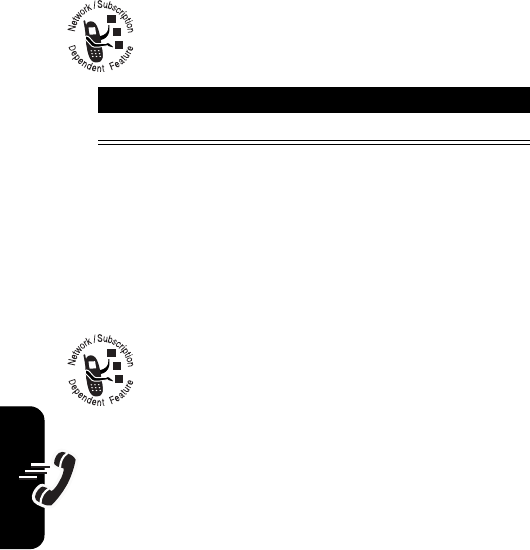
58
Calling Features
Using Automatic Redial
When you receive a busy signal, your phone
displays
Call Failed, Number Busy
.
When the call goes through, your phone rings or vibrates
one time, displays
Redial Successful
, and connects the call.
Using Caller ID
Incoming Calls
Calling line identification (caller ID) displays the
phone number for incoming calls in your
phone’s external and internal displays.
The phone displays the caller’s name (and
picture ID, if available) when the name is stored in your
phonebook, or
Incoming Call
when caller ID information is
not available.
You can also set your phone to play a distinctive ringer ID
for specific entries stored in your phonebook. For more
information, see page 75.
Press To
s
or
RETRY
(
r
) redial the number

59
Calling Features
Outgoing Calls
You can show or hide your phone number as an
ID for the calls that you make.
You can override the default caller ID setting when you
make a call. While dialing (with digits visible in the display):
Canceling an Incoming Call
While the phone is ringing or vibrating:
Depending on your phone settings and/or
service subscription, the call may be
forwarded to another number, or the caller may
hear a busy signal.
Find the Feature
m
>
Settings
>
In-Call Setup
>
My Caller ID
Press To
m
>
Hide ID
/
Show ID
hide or show your caller ID for
the next call
Press To
IGNORE
(
l
) cancel the incoming call

60
Calling Features
Turning Off a Call Alert
You can turn off your phone’s incoming call alert before
answering the call.
Calling an Emergency Number
Your service provider programs one or more emergency
phone numbers, such as 911 or 112, that you can call
under any circumstances, even when your phone is locked
or the SIM card is not inserted.
Note:
Emergency numbers vary by country. Your phone’s
preprogrammed emergency number(s) may not work in all
locations, and sometimes an emergency call cannot be
placed due to network, environmental, or interference
issues.
Dialing International Numbers
Press and hold
0
to insert the local international access
code (
+
) for the country from which you are calling, then
press the keypad keys as usual to dial the phone number.
Press To
either volume key turn off the alert
Press To
1
keypad keys dial the emergency number
2
s
call the emergency number

61
Calling Features
Viewing Recent Calls
Your phone keeps lists of the calls you recently received
and dialed, even if the calls did not connect. The lists are
sorted from newest to oldest entries. The oldest entries are
deleted as new entries are added.
Shortcut:
Press
s
from the home screen to view the
dialed calls list.
Find the Feature
>
Recent Calls
Press To
1
n
scroll to
Received Calls
or
Dialed Calls
2
SELECT
(
r
) select the list
3
n
scroll to an entry
Note:
<
means the call
connected.
4
s
or
VIEW
(
r
)
or
m
call the entry’s number
Tip:
Press and hold
s
for
2 seconds to send the
number as DTMF tones
during a call.
view entry details
open the
Last Calls Menu
to
perform various operations
on the entry
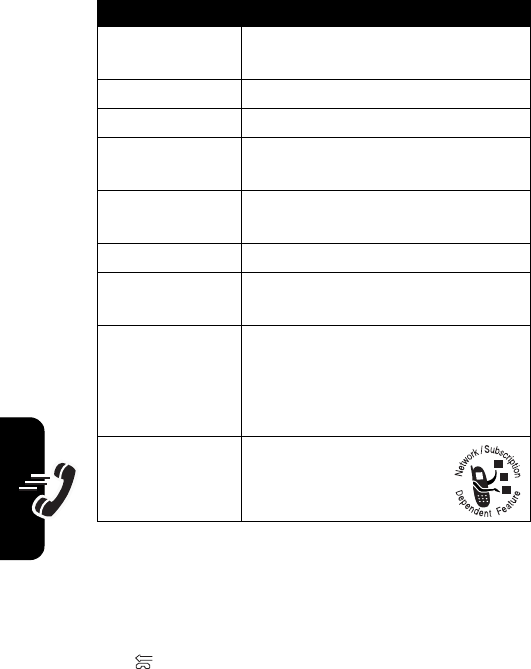
62
Calling Features
The
Last Calls Menu
can include the following options:
Returning an Unanswered Call
Your phone keeps a record of your unanswered calls, and
displays:
•
the (missed call) indicator
Option Description
Store
Create a phonebook entry with
the number in the
No.
field.
Delete
Delete an entry.
Delete All
Delete all entries in the list.
Hide ID
/
Show ID
Hide or show your caller ID for the
next call.
Send Message
Open a new text message with the
number in the
To
field.
Add Digits
Add digits after a number.
Attach Number
Attach a number from the
phonebook or recent calls lists.
Send Tones
Send the number to the network
as DTMF tones.
Note:
This option displays only
during a call.
Talk then Fax
Talk and then send a
fax in the same call
(see page 83).

63
Calling Features
•
X Missed Calls
, where
X
is the number of missed calls
Using the Notepad
The most recent set of digits entered on the keypad are
stored in your phone’s notepad memory. This can be a
phone number that you called, or a number that you
entered but did not call. To retrieve the number stored in
the notepad:
Press To
1
VIEW
(
r
) see the received calls list
2
n
select a call to return
3
s
make the call
Find the Feature
m
>
Recent Calls
>
Notepad
Press To
s
or
m
or
STORE
(
r
)
call the number
open the
Dialing Menu
to attach
a number or insert a special
character
create a phonebook entry
with the number in the
No.
field

64
Calling Features
Attaching a Number
While dialing (with digits visible in the display):
Calling With Speed Dial
Each entry you store in your phonebook is assigned a
unique speed dial number.
Tip:
To see an entry’s speed dial number, press
m
>
Phonebook
, scroll to the entry, press
VIEW
(
r
).
To speed dial a phonebook entry:
Calling With 1-Touch Dial
To call phonebook entries 1 through 9, press and hold the
single-digit speed dial number for one second.
Tip:
You must specify which phone number list you want
to use with this feature: phone memory phonebook, or SIM
card phonebook (see page 77).
Press To
m
>
Attach Number
attach a number from the
phonebook or recent calls
lists
Press To
1
keypad keys enter the speed dial number
for the entry you want to call
2
h
submit the number
3
s
call the entry

65
Calling Features
Using Voicemail
Voicemail messages that you receive are stored
on the network. To listen to your messages, you
must call your voicemail phone number.
Note:
Your service provider may include
additional information about using this feature.
Listening to Voicemail Messages
The phone calls your voicemail phone number. If no
voicemail number is stored, your phone prompts you to
store a number.
Receiving a Voicemail Message
When you receive a voicemail message, your phone
displays the
&
(voicemail message) indicator and the
New Voicemail
notification.
The phone calls your voicemail phone number. If no
voicemail number is stored, your phone prompts you to
store a number.
Find the Feature
m
>
Messages
>
Voicemail
Press To
CALL
(
r
) listen to the message
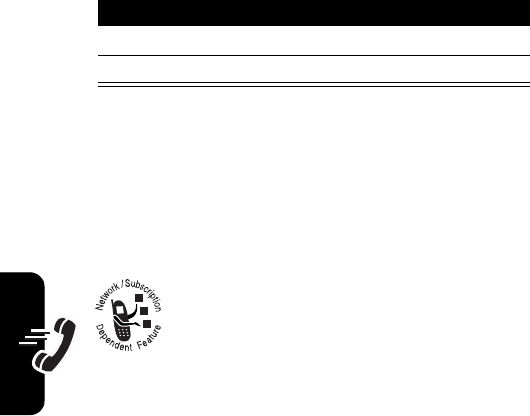
66
Calling Features
Storing Your Voicemail Number
If necessary, use the following procedure to store your
voicemail phone number on your phone. Usually, your
service provider has already done this for you.
Note:
You cannot store a
p
(pause),
w
(wait), or
n
(number)
character in this number. If you want to store a voicemail
number with these characters, create a phonebook entry
for it. Then, you can use the entry to call your voicemail.
Using Call Waiting
When you are on a call, an alert tone sounds
to indicate that you have received a second
call.
Find the Feature
m
>
Messages
m
>
Voicemail Setup
Press To
1
keypad keys enter your voicemail number
2
OK
(
r
) store the number

67
Calling Features
You must turn on call waiting to use the feature. To turn
call waiting on or off:
Putting a Call On Hold
Transferring a Call
You can announce that you are transferring an
active call to another party, or you can directly
transfer the call.
Press To
1
s
answer the new call
2
SWITCH
(
r
)
or
LINK
(
l
)
or
m
>
EndCallOnHold
switch between calls
connect the 2 calls
end the call on hold
Find the Feature
m
>
Settings
>
In-Call Setup
>
Call Waiting
Press To
HOLD
(
r
) (if available) or
m
>
Hold
put the call on hold
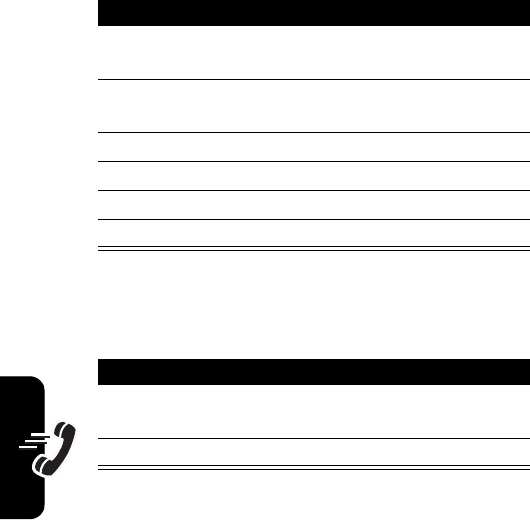
68
Calling Features
Announce the Call Transfer
Do Not Announce the Call Transfer
Find the Feature
m
>
Hold
Press To
1
keypad keys dial the number where you
are transferring the call
2
s
call the number and speak to
the person who answers
3
m
open the menu
4
n
scroll to
Transfer
5
SELECT
(
r
)select
Transfer
6
OK
(
r
) confirm the transfer
Find the Feature
m
>
Transfer
Press To
1
keypad keys dial the number where you
are transferring the call
2
s
transfer the call

69
Phone Features
Phone Features
Main Menu
This is the standard main menu layout.
Menu
organization and feature names may vary on your
phone.
Not all features may be available on your phone.
n
Phonebook
s
Recent Calls
• Received Calls
• Dialed Calls
• Notepad
•Call Times
•Call Cost
•Data Times
•Data Volumes
e
Messages
• Create Message
• Message Inbox
•Voicemail
• Email Msgs
•Browser Msgs
•Info Services
•Quick Notes
•Outbox
•Drafts
• MMS Templates
É
Office Tools
• SIM Apps
•Calculator
• Datebook
•Shortcuts
•Alarm Clock
• Dialing Services
•Fixed Dial
• Service Dial
• Quick Dial
• Activation List
Q
Games & Apps
á
Web Access
•Browser
• Web Shortcuts
•Stored Pages
•History
•Go To URL
•Browser Setup
• Web Sessions
h
Multimedia
•Themes
•Camera
•Pictures
• Sounds
•MotoMixer
•Videos
ã
IM
w
Settings
(see next page)
K
Chat

70
Phone Features
Settings Menu
l
Personalize
• Home Screen
•Main Menu
•Skin
• Greeting
• Wallpaper
• Screen Saver
• Quick Dial
t
Ring Styles
•Style
•Style Detail
L
Connection
•Sync
• USB Settings
H
Call Forward
•Voice Calls
•Fax Calls
• Data Calls
•Cancel All
• Forward Status
U
In-Call Setup
•In-Call Timer
•Call Cost Setup
•My Caller ID
• Talk and Fax
• Answer Options
• Call Waiting
Z
Initial Setup
• Time and Date
• 1-Touch Dial
• Display Timeout
• Backlight
• TTY Setup
•Scroll
• Language
•Brightness
•DTMF
•Master Reset
•Master Clear
m
Phone Status
•My Tel. Numbers
• Credit Info/Available
•Active Line
• Battery Meter
• Other Information
S
Headset
• Auto Answer
•Voice Dial
J
Car Settings
• Auto Answer
• Auto Handsfree
• Power-Off Delay
•Charger Time
j
Network
•New Network
•Network Setup
• Available Networks
• My Network List
• Service Tone
• Call Drop Tone
u
Security
• Phone Lock
• Lock Keypad
• Lock Application
•Fixed Dial
• Call Barring
•SIM PIN
•New Passwords
c
Java Settings
• Java System
• Delete All Apps
• App Vibration
• App Volume
• App Priority
• App Backlight
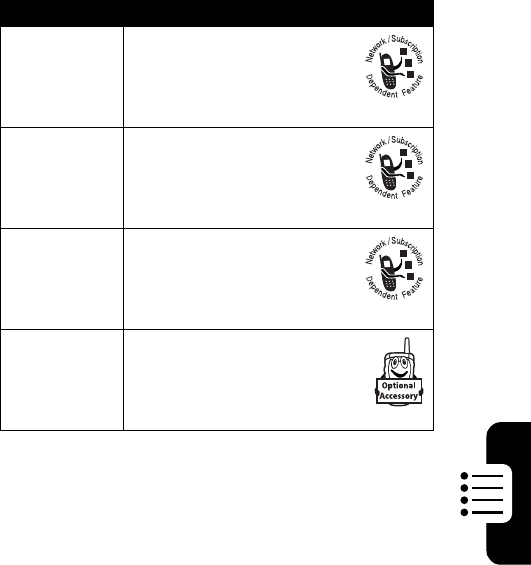
71
Phone Features
Feature Quick Reference
This section helps you locate features on your phone that
are not described in this guide. For more detailed
information, see Motorola Web site (described on page 8).
Calling Features
Feature Description
Conference
Call
During a call:
m
>
Hold
, dial next
number, press
s
, press
LINK
(
l
)
Call
Forwarding
Set up or cancel call
forwarding:
m
>
Settings
>
Call Forward
Call Barring
Restrict outgoing or
incoming calls:
m
>
Settings
>
Security
>
Call Barring
TTY Calls
Set up your phone for use
with an optional TTY device:
m
>
Settings
>
Initial Setup
>
TTY Setup
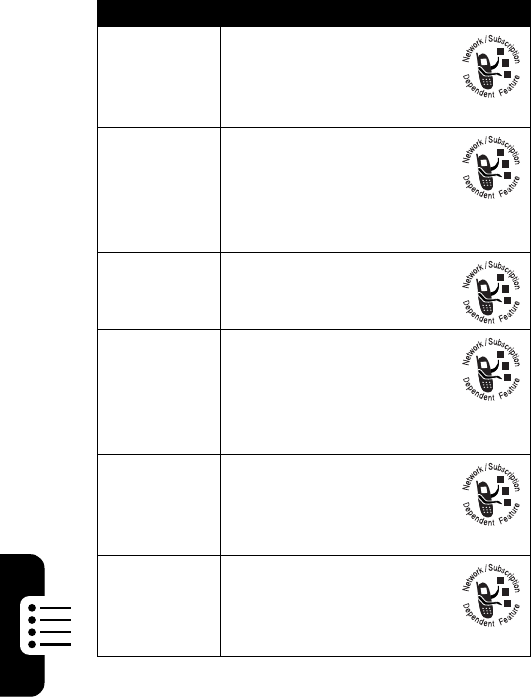
72
Phone Features
Messages
Feature Description
Send Text
Message
Send a text message:
m
>
Messages
>
Create Message
>
New Short Message
Send
Multimedia
Message
Send a multimedia
message:
m
>
Messages
>
Create Message
>
New Multimedia Msg
Send Letter
Send a multimedia letter:
m
>
Messages
>
Create Message
>
New Letter
Use MMS
Template
Open an MMS template
with preloaded media:
m
>
Messages
>
Create Message
>
MMS Templates
Read
Message
Read a new text or
multimedia message that
you have received:
Press
READ
(
r
).
Store
Message
Objects
Go to a multimedia
message slide, or highlight
an object in a letter, then:
m
>
Store
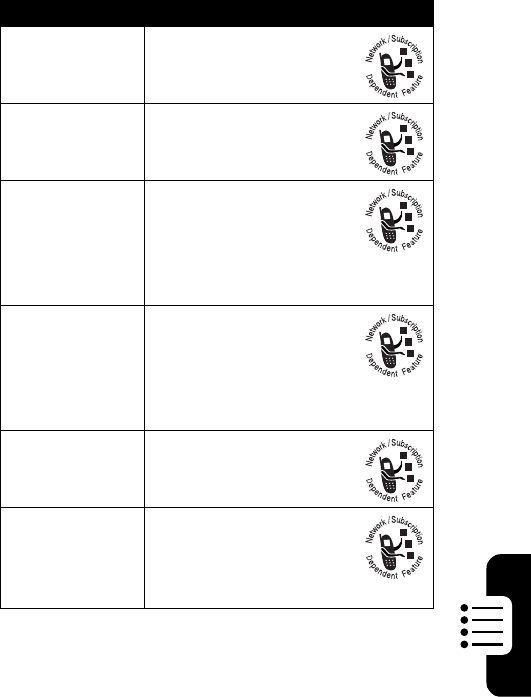
73
Phone Features
Instant Messaging
Feature Description
Log In
Log in to instant
messaging:
m
>
IM
>
Log In
Find Others
Online
After you sign on:
Select
Contact List
to see a
list of other users.
Start
Conversation
Start a conversation:
From your
Contact List
,
highlight a name in
Online Contacts
, press
SEND IM
(
r
).
Open Active
Conversation
Open a conversation in
progress:
From your
Contact List
,
highlight a name in
Conversations
, press
VIEW
(
r
).
End
Conversation
From the conversation
display:
m
>
End Conversation
Log Out
Log out of instant
messaging:
Select
Log Out
from the
IM Online
menu.
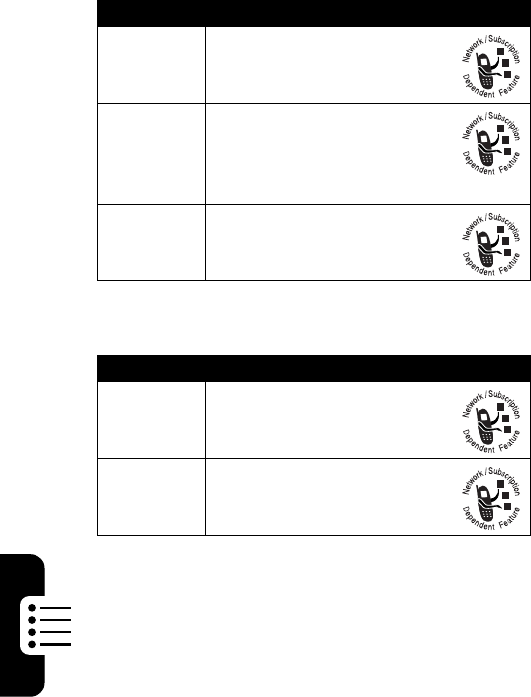
74
Phone Features
Chat
Email
Feature Description
Start Chat
Start a new chat session:
m
>
Chat
m
>
New Chat
Receive
Chat
Request
When you receive a chat
request:
Press
ACCEPT
(
r
) or
IGNORE
(
l
).
End Chat
During a chat session:
m
>
End Chat
Feature Description
Send
Email
Message
Send an email message:
m
>
Messages
>
Create Message
>
New Email
Read
Email
Message
Read a new email message
that you have received:
Press
READ
(
r
).

75
Phone Features
Phonebook
Feature Description
Create Entry
Create a new phonebook entry:
m
>
Phonebook
m
>
New
>
Phone Number
or
Email Address
Create
Group
Mailing List
Create a group mailing list as a
phonebook entry:
m
>
Phonebook
m
>
New
>
Mailing List
Dial Number
Call a number stored in the
phonebook:
m
>
Phonebook
, highlight the
phonebook entry, press
s
to call
Voice Dial
Number
Voice dial a number stored in the
phonebook:
From the home screen, press
V.DIAL
(
r
), then say the entry’s
name (within 2 seconds) to call.
Note:
This option is not available for
entries stored on the SIM card.
Voice Dial
Key
Voice dial key is used to active Voice
dial.
m
>
Settings
>
Personalize
>
Home Screen
>
Home Keys
>
RightSoftKey
and select
Voice Dial
Note:
Also
Left Soft Key, Up, Down, Left
and
Right
keys can be used.
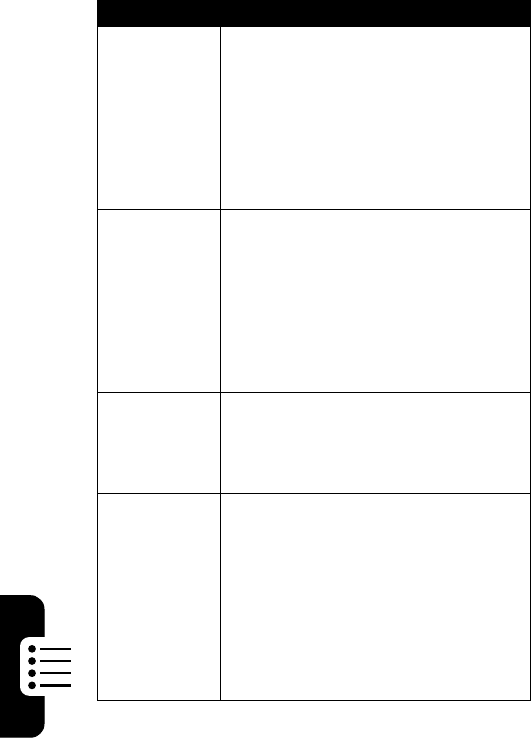
76
Phone Features
Set Ringer
ID for Entry
Assign a distinctive ringer alert to a
phonebook entry:
m
>
Phonebook
> entry
m
>
Edit
>
Ringer ID
> ringer name
Note:
The
Ringer ID
option is not
available for entries stored on the
SIM card.
Set Picture
ID for Entry
Assign a photo or picture to a
phonebook entry:
m
>
Phonebook
> entry
m
>
Edit
>
Picture
> picture name
Note:
The
Picture
option is not
available for entries stored on the
SIM card.
Set Picture
ID View
View phonebook entries as text list,
or with picture caller ID photos:
m
>
Phonebook
m
>
Setup
>
View by
> list view
Set
Category for
Entry
Set the category for a phonebook
entry:
m
>
Phonebook
> entry
m
>
Edit
>
Category
>category name
Note:
The
Category
option is not
available for entries stored on the
SIM card.
Feature Description
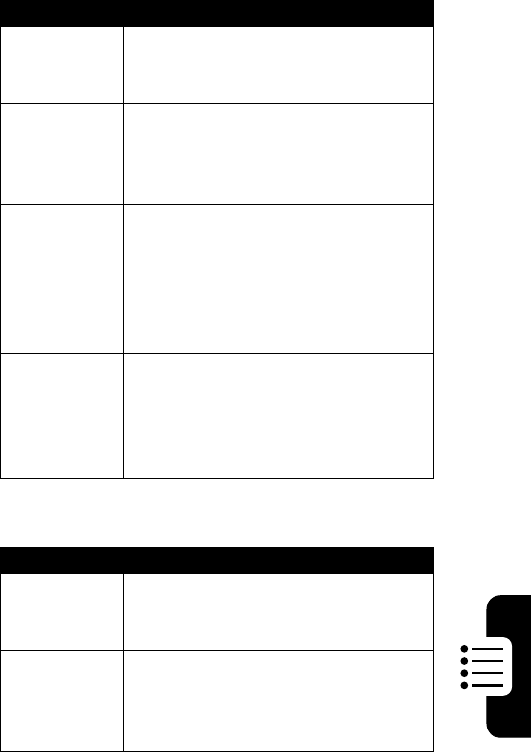
77
Phone Features
Personalizing Features
Set
Category
View
Set a phonebook category view:
m
>
Phonebook
m
>
Categories
> category view
Sort
Phonebook
List
Set the order in which phonebook
entries are listed:
m
>
Phonebook
m
>
Setup
>
Sort by
> sort order
Set Primary
Number
Set the primary number for a
phonebook entry with multiple
numbers:
m
>
Phonebook
, scroll to entry,
press
m
>
Set Primary
>phone number
1-Touch
Dial
Set 1-touch dial to call entries stored
in your phone memory phonebook or
the SIM card phonebook:
m
>
Settings
>
Initial Setup
>
1-Touch Dial
Feature Description
Ring Style
Change the ring alert for an event:
m
>
Settings
>
Ring Styles
>Style
Detail
> event name
Ringer IDs
Activate distinctive ring alerts
assigned to phonebook entries:
m
>
Settings
>
Ring Styles
>Style
Detail
>
Ringer IDs
Feature Description
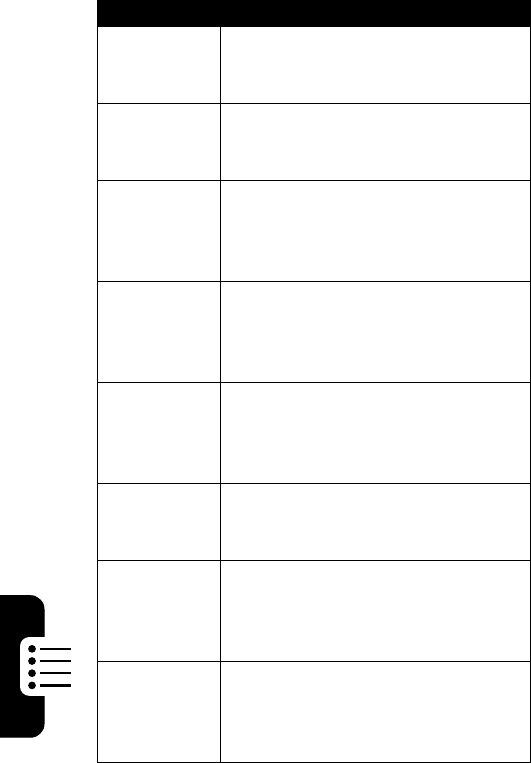
78
Phone Features
Ring
Volume
Set ringer volume:
m
>
Settings
>
Ring Styles
>Style
Detail
>
Ring Volume
Keypad
Volume
Set keypad keypress volume:
m
>
Settings
>
Ring Styles
>Style
Detail
>
Key Volume
Reminders
Set reminder alerts for messages
that you receive:
m
>
Settings
>
Ring Styles
>Style
Detail
>
Reminders
Clock View
Display an analog clock or digital
time readout in the home screen:
m
>
Settings
>
Personalize
>
Home Screen
>
Clock
Menu View
Display the main menu as graphic
icons or as a text-based list:
m
>
Settings
>
Personalize
>
Main Menu
>
View
Main Menu
Reorder your phone’s main menu:
m
>
Settings
>
Personalize
>
Main Menu
>
Reorder
Show or
Hide Menu
Icons
Show or hide menu feature icons in
the home screen:
m
>
Settings
>
Personalize
>
Home Screen
>
Home Keys
>
Icons
Change Soft
Keys &
Menu Icons
Change soft key labels and menu
feature icons in the home screen:
m
>
Settings
>
Personalize
>
Home Screen
>
Home Keys
Feature Description
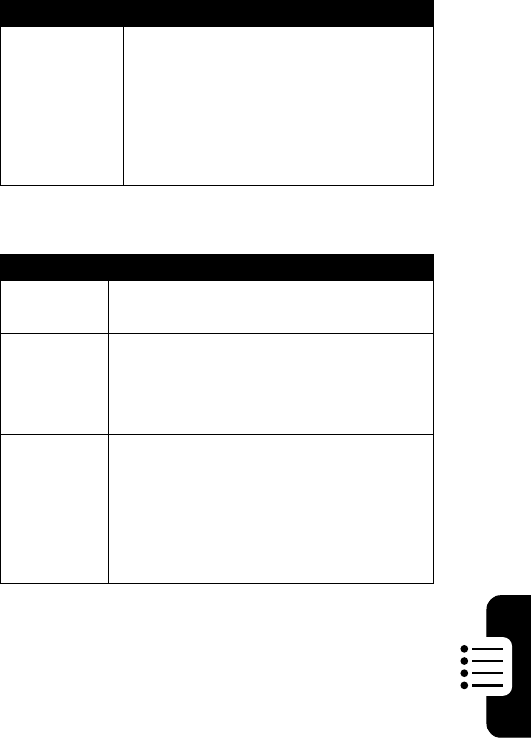
79
Phone Features
Menu Features
Shortcuts
Create a shortcut to a menu item:
Highlight the menu item, then press
and hold
m
.
Select a shortcut:
m
>
Office Tools
>
Shortcuts
>shortcut name
Feature Description
Language
Set menu language:
m
>
Settings
>
Initial Setup
>
Language
Master
Reset
Reset all options except unlock code,
security code, and lifetime timer:
m
>
Settings
>
Initial Setup
>
Master Reset
Master
Clear
Reset all options except unlock code,
security code, and lifetime timer, and
clear all user settings and entries
except SIM card information:
m
>
Settings
>
Initial Setup
>
Master Clear
Feature Description
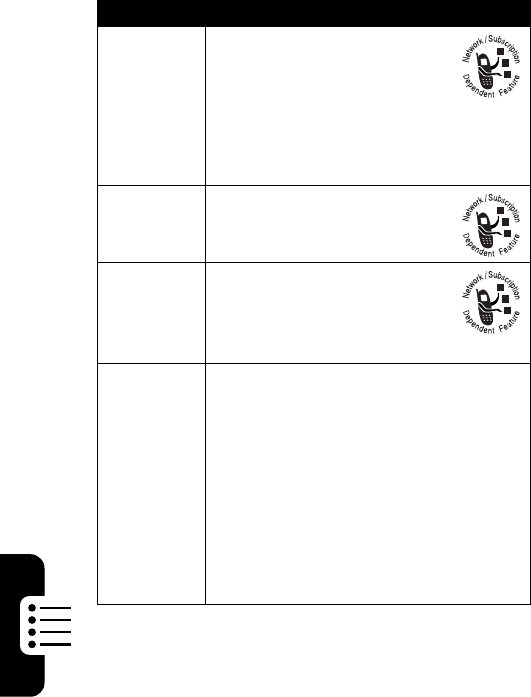
80
Phone Features
Dialing Features
Call Monitoring
Network connection time
is the elapsed time from the
moment you connect to your service provider's network to
Feature Description
Fixed Dial
Turn fixed dialing on or off:
m
>
Settings
>
Security
>
Fixed Dial
Use the fixed dial list:
m
>
Office Tools
>
Dialing Services
>
Fixed Dial
Service
Dial
Dial service phone numbers:
m
>
Office Tools
>
Dialing Services
>
Service Dial
Quick Dial
Dial preprogrammed phone
numbers:
m
>
Office Tools
>
Dialing Services
>
Quick Dial
DTMF
Tones
Activate DTMF tones:
m
>
Settings
>
Initial Setup
>
DTMF
Send DTMF tones during a call:
Press number keys.
Send stored numbers as DTMF tones
during a call:
Highlight a number in the phonebook
or recent calls lists, then press
m
>
Send Tones
.
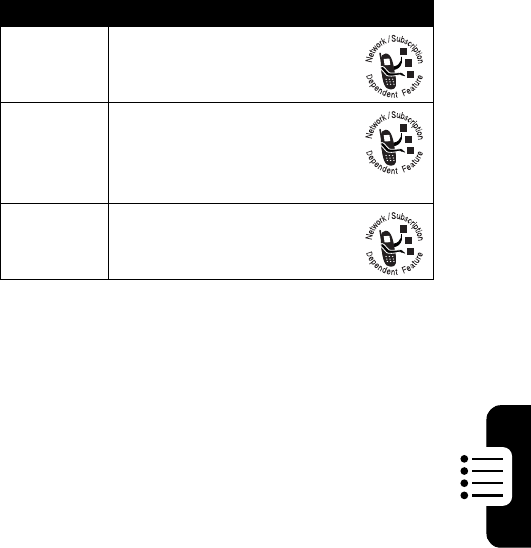
81
Phone Features
the moment you end the call by pressing
e
. This time
includes busy signals and ringing.
The amount of network connection time you track on
your resettable timer may not equal the amount of
time for which you are billed by your service provider.
For billing information, please contact your service
provider directly.
Handsfree Features
Note:
The use of wireless devices and their accessories
may be prohibited or restricted in certain areas. Always
Feature Description
Call Times
View call timers:
m
>
Recent Calls
>
Call Times
In-Call
Timer
Display time or cost
information during a call:
m
>
Settings
>
In-Call Setup
>
In-Call Timer
Call Cost
View call cost trackers:
m
>
Recent Calls
>
Call Cost
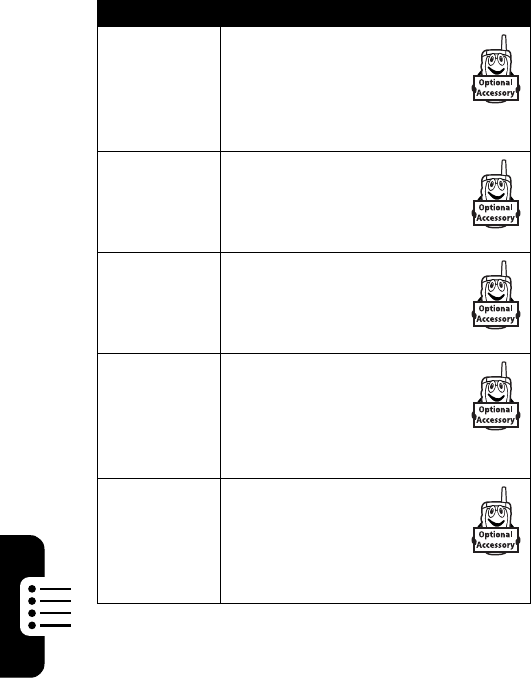
82
Phone Features
obey the laws and regulations on the use of these
products.
Feature Description
Auto
Answer
(car kit or
headset)
Automatically answer calls
when connected to a car kit
or headset:
m
>
Settings
>
Car Settings
or
Headset
>
Auto Answer
Voice Dial
(headset) Enable voice dial with
headset send/end key:
m
>
Settings
>
Headset
>
Voice Dial
Auto
Handsfree
(car kit)
Automatically route calls to a
car kit when connected:
m
>
Settings
>
Car Settings
>
Auto Handsfree
Power-Off
Delay
(car kit)
Set the phone to stay on for
a specified time after the
ignition is switched off:
m
>
Settings
>
Car Settings
>
Power-Off Delay
Charger
Time
(car kit)
Charge the phone for a
specified time after the
ignition is switched off:
m
>
Settings
>
Car Settings
>
Charger Time
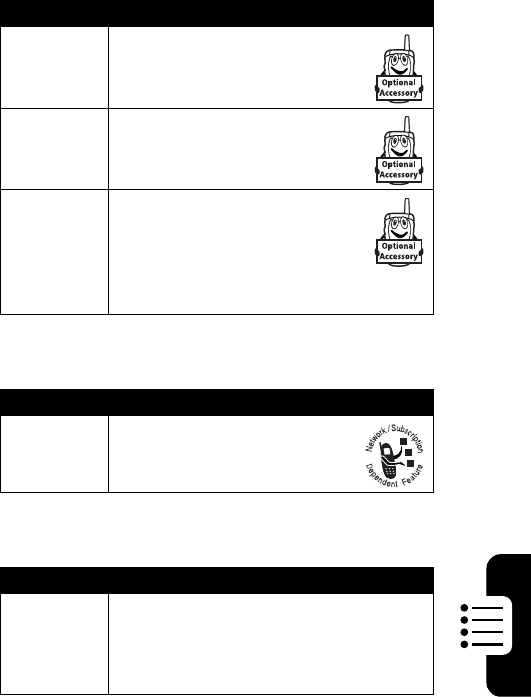
83
Phone Features
Data and Fax Calls
Network Features
Personal Organizer Features
Feature Description
Send Data
or Fax
Connect your phone to the
device, then place the call
through the device application.
Receive
Data or
Fax
Connect your phone to the
device, then answer the call
through the device application.
Talk Then
Fax
Connect your phone to the
device, enter the number,
press
m
>
Dialing Menu
>
Talk Then Fax
, then press
s
to
make the call.
Feature Description
Network
Settings
View network information and
adjust network settings:
m
>
Settings
>
Network
Feature Description
Create
Datebook
Event
Create a new datebook event:
m
>
Office Tools
>
Datebook
, highlight
the day, press the center select button,
press
m
>
New
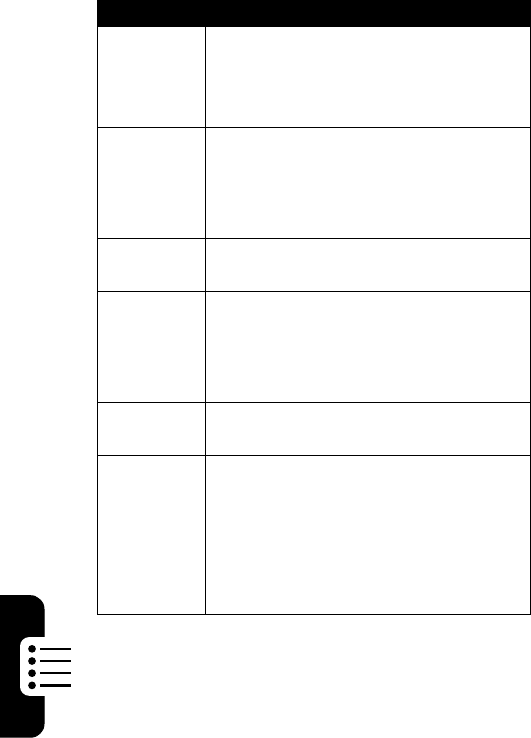
84
Phone Features
View
Datebook
Event
View or edit event details:
m
>
Office Tools
>
Datebook
, highlight
the day, press the center select button,
press
VIEW
(
r
)
Event
Reminder
View event reminder:
VIEW
(
r
)
Dismiss event reminder:
EXIT
(
l
)
Set Alarm
Set an alarm:
m
>
Office Tools
>
Alarm Clock
Turn Off
Alarm
Turn off alarm:
Press
DISABLE
(
l
) or
e
.
Set 8-minute delay:
Press
SNOOZE
(
r
).
Calculator
Calculate numbers:
m
>
Office Tools
>
Calculator
Currency
Converter
Convert currency:
m
>
Office Tools
>
Calculator
m
>
Exchange Rate
Enter exchange rate, press
OK
(
r
),
enter amount, press
m
>
Convert Currency
.
Feature Description
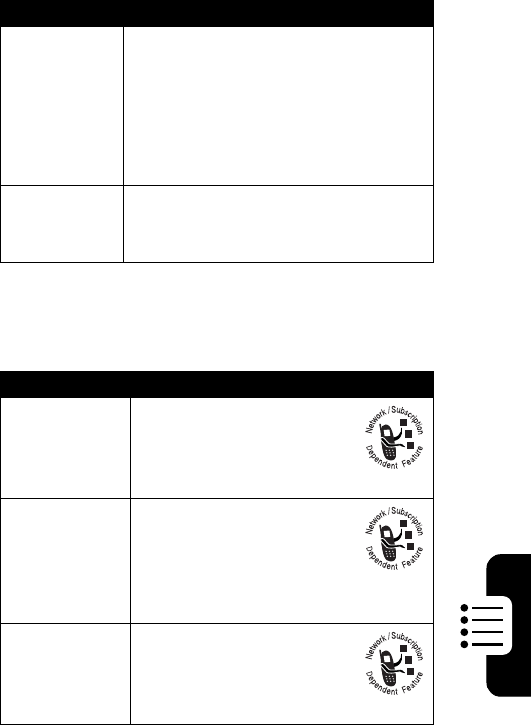
85
Phone Features
Security
News and Entertainment
Note:
Normal airtime and/or carrier usage charges apply.
Feature Description
SIM PIN
Lock or unlock the SIM card:
m
>
Settings
>
Security
>
SIM PIN
Caution:
If you enter an incorrect
PIN code 3 times in a row, your SIM
card is disabled and your phone
displays
SIM Blocked
.
Lock
Application
Lock phone applications:
m
>
Settings
>
Security
>
Lock Application
Feature Description
Launch
Micro-
Browser
Start a micro-browser
session:
m
>
Web Access
>
Browser
Download
Objects from
Web Page
Download a picture,
sound, or phone theme
from a Web page:
Highlight the file, press
SELECT
(
r
), press
STORE
(
r
).
Web
Sessions
Select or create a Web
session:
m
>
Web Access
>
Web Sessions
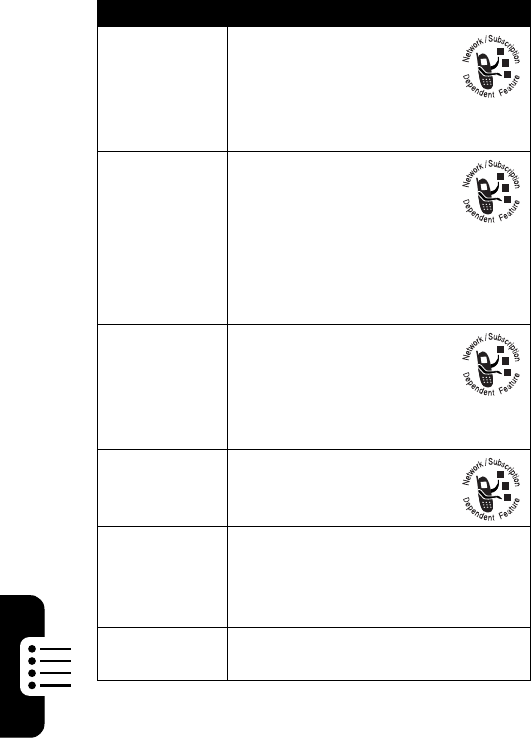
86
Phone Features
Apply Phone
Theme
Apply a grouped set of
image and sound files to
your phone:
m
>
Multimedia
>
Themes
>theme
Download
Game or
Application
(Micro-
Browser)
Download a Java™ game
or application with the
micro-browser:
m
>
Web Access
>
Browser
, highlight the application,
press
SELECT
(
r
), press
DWNLOAD
(
r
)
Launch
Game or
Application
Launch a Java™ game or
application:
m
>
Games & Apps
,
highlight the application,
press
SELECT
(
r
)
Manage
Pictures
Manage pictures and
animations:
m
>
Multimedia
>
Pictures
Manage
Sounds
Manage ring tones and music that
you have composed or
downloaded:
m
>
Multimedia
>
Sounds
Manage
Video Clips
Manage video clips:
m
>
Multimedia
>
Videos
Feature Description

87
Phone Features
Edit Sounds
With
MotoMixer
Edit MIDI-based songs that you can
use with your phone:
m
>
Multimedia
>
MotoMixer
>
[New Mix]
or mix file name
Create Ring
Tones
Create iMelody ring tones that you
can use with your phone:
m
>
Multimedia
>
Sounds
>
[New iMelody]
Camera
Adjust light level and other settings
for the integrated camera:
m
>
Multimedia
>
Camera
m
>
Pictures Setup
Feature Description

88
Phone Features

89
Troubleshooting
Troubleshooting
If you have questions or need assistance, we're here to
help. Go to www.motorola.com/consumer/support, where
you can select from a number of customer care options.
You can also contact the Motorola Customer Support
Center at 1-800-331-6456 (United States),
1-888-390-6456 (TTY/TDD United States for hearing
impaired), or 1-800-461-4575 (Canada).

90
Specific Absorption Rate Data
This model phone meets the international standards for exposure to
radio waves.
Your mobile phone is a radio transmitter and receiver. It is designed and
manufactured not to exceed limits for exposure to radio frequency (RF)
energy. These limits are part of comprehensive guidelines and establish
permitted levels of RF energy for the general population. The guidelines
are based on standards that were developed by independent scientific
organizations through periodic and thorough evaluation of scientific
studies. The guidelines include a substantial safety margin designed to
assure the safety of all persons, regardless of age and health.
The exposure standard for mobile phones employs a unit of
measurement known as the Specific Absorption Rate, or SAR. Under the
guidelines for your phone model, the SAR limit is 2.0 W/kg.
1
Tests for
SAR are conducted in accordance with CENELEC
2
testing procedures
using standard operating positions with the phone transmitting at its
highest certified power level in all tested frequency bands. Although the
SAR is determined at the highest certified power level, the actual SAR of
the phone while operating can be well below the maximum value. This is
because the phone is designed to operate at multiple power levels so as
to use only the power required to reach the network. In general, the closer
you are to a base station, the lower the power output of the phone.
Before a phone model is available for sale to the public, it is tested to
confirm compliance with the guidelines. The tests are performed in
positions that conform to a uniform testing methodology determined by an
expert standards body. The highest SAR value for this model phone when
tested for use at the ear is ____ W/kg.
3
While there may be differences between the SAR levels of various
phones and at various positions, they all meet the governmental
requirements for safe exposure. Please note that improvements to this
91
product model could cause differences in the SAR value for later
products; in all cases, products are designed to be within the guidelines.
1. The SAR limit recommended by international guidelines (ICNIRP) for mobile
phones used by the public is 2.0 watts/kilogram (W/kg) averaged over ten
grams of tissue. The limit incorporates a substantial margin for safety to give
additional protection for the public and to account for any variations in
measurements.
2. CENELEC is a European Union standards body.
3.
Additional related information includes the Motorola testing protocol,
assessment procedure, and measurement uncertainty range for this product.

92
Index
A
accessories 8
active line indicator 29
active line, changing 57
alarm clock 84
alert
creating 87
defined 52
setting 14, 52, 77
turning off 14, 60
animation
downloading 72, 85
screen saver 54
viewing 86
wallpaper 53
answering a call 15, 53
application, locking and
unlocking 85
automatic redial 58
B
backlight 55
barring calls 71
battery
charging 11
extending battery life 9,
27, 54, 55
installing 10
level indicator 30
browser. See micro-browser
C
calculator 84
call
adding digits after phone
number 62
alert, turning off 14, 60
answering 15
barring 71
barring password,
changing 46
call waiting 66
canceling 59
costs 81
deleting 61
dialed calls list 61
dialing 14
emergency number 60
ending 14, 15
forwarding 71
handsfree speaker 45
hold 67
international access code
60
making 14
93
multi-key answer 53
received calls list 61
receiving 15
recent calls 61
ring style 14, 52, 77
storing 61
talk then fax 62
timers 81
transferring 67
unanswered call 62
Call Failed, Number Busy
message 58
call waiting 66
caller ID 20, 50, 58, 62, 76
calling line identification.
See caller ID
camera
settings 87
taking a photo 2, 18
car kit 82
character chart 39
chat 74
clock
illustration 26
selecting analog or digital
78
setting 52
codes
changing 46
default 46, 47, 48
forgetting 48
conference call 71
cursor 35
customizing the menu 78
D
data call 83
date, setting 52
datebook 83, 84
deleting a call 61
dialed calls list 61
dialing a number 14, 80
display
backlight 55
description 26
home screen 26
language 79
personalizing 78
skin 3, 20
timeout 56
distinctive ringer alert 77
drafts folder 24
DTMF tones
activating 80
sending 61, 62, 80
E
earpiece volume 14
email 74
draft 24
reminders, turning on/off
78
emergency number 60
94
end key 14, 15
ending a call 14, 15
Enter Unlock Code
message 47, 48
F
fax call 62, 83
5-way navigation joystick
31
fixed dial 80
flashing cursor 35
forwarding calls 71
G
games 86
GPRS indicator 28
groove tunes 87
H
handsfree speaker 45
handsfree use 81
headset accessory, using
81
Hide ID feature 62
hold a call 67
home keys, personalizing
78
home screen
defined 26
selecting clock view 78
I
IM 73
incoming call
answering 15
canceling 59
forwarding 71
Incoming Call message 58
indicators
active line 29
battery level 30
GPRS 28
Java midlet 30
location 31
loud ring style 31
message 30
messaging presence 30
missed call 62
ring style 31
roam 29
signal strength 29
silent alert 31
soft ring style 31
text case 36
text entry mode 36
transmission 28
vibrate alert 31
vibrate and ring style 31
voicemail message 30,
65
instant messaging. See IM
95
international access code
60
iTAP software 40
J
Java applications 86
Java midlet indicator 30
joystick 31
K
key
end 14, 15
left soft key 27, 78
lock 16
menu 33
operator 45
power 13
right soft key 27, 78
send 14, 15, 61
volume control 14
keypad
answering calls 53
locking and unlocking 16
volume, setting 78
L
language, setting 79
left soft key
functions 27
personalizing 78
line, changing 57
location indicator 31
lock
application 85
keypad 16
phone 46
SIM card 85
Low Battery message 30
M
making a call 14
master clear 79
master reset 79
menu
entering text 34
icons, changing in home
screen 78
icons, converting to text
78
icons, described 26
icons, showing or hiding
78
language, setting 79
lists 33
navigating 32
personalizing 78
rearranging features 78
using features 33
view, changing 78
menu key 33
message
chat 74
96
menu feature icon 26
MMS template 72
MMS, defined 21
multimedia letter 72
multimedia message 72
reading 72
reminders, turning on/off
78
text 72
message indicator 30
messages menu feature
icon 26
messaging presence
indicator 30
micro-browser
browser setup 85
Java applications 86
menu feature icon 26
using 85
Web sessions 85
missed call indicator 62
Missed Calls message 63
MMS template 72
MMS. See message
MotoMixer 87
multimedia letter, sending
72
multimedia message
sending 3, 21, 72
multimedia messaging
service. See
message
music
downloading 72, 85
managing 86
playlist 3, 17
my telephone number 15,
52
N
network settings 83
notepad 63
number
storing your number 52
viewing your number 15
numbers, entering 42
O
1-touch dial
setting preference 77
using 64
operator key 45
optional accessory, defined
8
optional feature, defined 8
P
passwords. See codes
phone
active line indicator 29
active line, changing 57
alert, turning off 14, 60
97
clear stored information
79
codes 46
date, setting 52
keypad, answering calls
53
keypad, locking and
unlocking 16
language, setting 79
locking 46
multi-key answer 53
network settings 83
reset all options 79
ring style 14, 52, 77
security code 46
skin 3, 20
time, setting 52
turning on/off 13
unlock code 46
unlocking 13, 46, 47, 48
phone number
active line indicator 29
active line, changing 57
adding digits after 62
attaching 2 numbers 62,
64
international access code
60
redialing 57
storing in phonebook 75
storing your number 52
viewing your number 15
phone theme 86
phonebook
attaching 2 numbers 62,
64
category views 51, 77
dialing a number 75
entry category 76
group mailing list 75
1-touch dial 64
picture ID 20, 50, 58, 76
primary number, setting
77
ringer ID 76, 77
sorting entries 50, 77
speed dial number 64
storing an entry 75
voice dialing 75
photo
downloading 72, 85
picture ID 20, 50, 58, 76
sending 2, 18
taking 2, 18
picture
downloading 72, 85
screen saver 54
viewing 86
wallpaper 53
picture ID 20, 50, 58, 76
PIN code
changing 46
entering 85
PIN2 code, changing 46
98
playlist 3, 17
power key 13
predictive text entry 40
primary text entry mode 35
Q
quick dial 80
R
received calls list 61
recent calls 61
redial
automatic redial 58
busy number 57
reminders
turning on/off 78
right soft key
functions 27
personalizing 78
ring style indicators 31
ring style, setting 14, 52, 77
ring tone
creating 87
downloading 72, 85
editing with MotoMixer 87
managing 86
playlist 3
ringer ID
setting 76
turning on/off 77
ringer volume, setting 14,
78
roam indicator 29
S
screen saver 54
secondary text entry mode
35
security code
changing 46
default 46
forgetting 49
send key 14, 15, 61
service dial 80
shortcuts 79
Show ID feature 62
signal strength indicator 29
silent alert indicator 31
silent alert, setting 14, 52,
77
SIM Blocked message 13,
85
SIM card
defined 9
installing 9
locking 85
PIN code entry 13
PIN code, changing 46
PIN2 code, changing 46
precautions 9
99
SIM Blocked message
13, 85
SIM PIN code
changing 46
entering 85
SIM PIN2 code, changing
46
skin 3, 20
soft keys
functions 27
personalizing 78
song
downloading 72, 85
managing 86
playlist 3, 17
sound
downloading 72, 85
managing 86
Speaker On message 45
speakerphone
automatic answer 82
speed dial 64
storing a call 61
symbol chart 43
symbols, entering 43
T
talk then fax call 62
tap mode text entry 37
telephone number
storing your number 52
viewing your number 15
text
capitalization, changing
36
character chart 39
entering 34
entry mode, selecting 35
entry mode, setup 36
flashing cursor 35
iTAP software predictive
text entry 40
numeric mode 42
symbol chart 43
symbol mode 43
tap mode 37
text case indicator 36
text entry mode
selecting 35
setup 36
text entry mode indicator 36
theme 86
time, setting 52
timers 81
transfer a call 67
transmission indicator 28
travel charger 12
U
unlock
application 85
keypad 16
100
phone 46
unlock code
bypassing 48
changing 46
default 46, 47, 48
entering 13, 47, 48
forgetting 48
V
vibrate alert
setting 14, 52, 77
turning off 14, 60
video clip
downloading 72, 85
managing 86
playing 3, 24
voice dial 75, 82
voice key
dialing a number 75
Voice Record 51
voicemail 65
voicemail message indicator
30, 65
volume
earpiece 14
keypad 78
ringer 14, 78
volume key 14
W
wallpaper 53
Web pages 85
Web sessions 85
U.S. patent Re. 34,976
motorola.com